Introduction
This article will show some images I have taken of just three deciduous azaleas that have become popular landscape plants in their own right: R. calendulaceum, R. luteum, and R. occidentale. These species have also been used heavily in the development many modern deciduous azalea hybrids. For a complete discussion of all the deciduous azalea species and their related hybrids, check out Steve Henning's excellent article on
Deciduous Azaleas that accompanies this issue. Thanks, Steve!
I also want to give special thanks to Hans Eiberg who kindly provided some images of R. luteum in the wild in this piece. Hans has amassed a tremendous resource of rhododendron images and information on the
Danish Chapter of the ARS website.
This should be the English version of his site which is very helpful for us foreigners.
Rhododendron calendulaceum
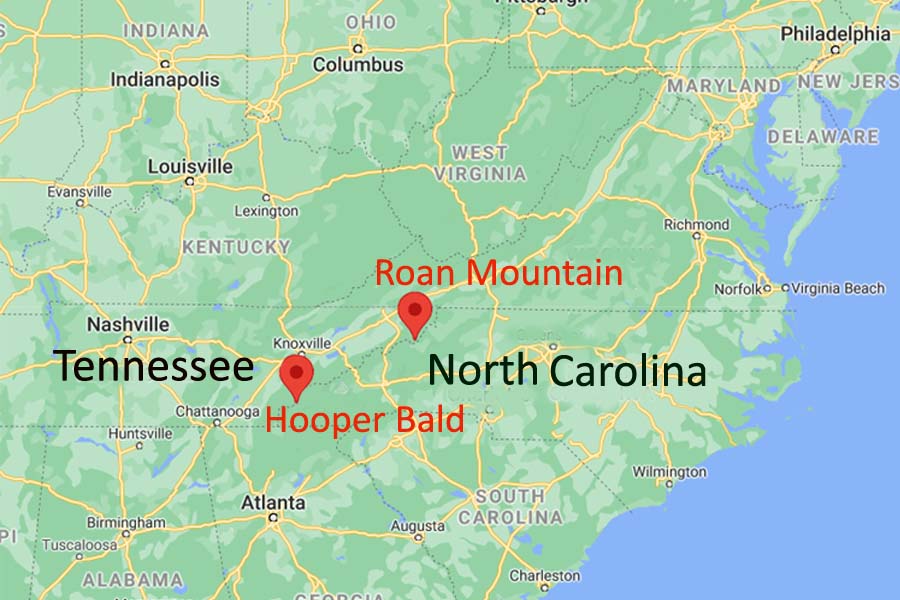 Rhododendron calendulaceum is surely one of the most highly prized of our North American native azaleas. The species is widespread in the Southern Appalachians and even a single plant sporting blossoms of brilliant yellow, orange, or red is a delight to behold. My favorite flame azalea display is along the Appalachian Trail at Roan Mountain located on the northern border between North Carolina and Tennessee. The trail winds through open balds at elevations of 5000 to 6000 ft (1500 to 1800 m) with 360-degree views. In June, huge stands of flame azaleas and masses of purple R. catawbiense burst into flower. The spectacle defies description. Farther to the south and still on the mountainous border between the two states is a second favorite spot, Hooper Bald. It has some of the largest flowered forms of the species we have ever seen.
Rhododendron calendulaceum is surely one of the most highly prized of our North American native azaleas. The species is widespread in the Southern Appalachians and even a single plant sporting blossoms of brilliant yellow, orange, or red is a delight to behold. My favorite flame azalea display is along the Appalachian Trail at Roan Mountain located on the northern border between North Carolina and Tennessee. The trail winds through open balds at elevations of 5000 to 6000 ft (1500 to 1800 m) with 360-degree views. In June, huge stands of flame azaleas and masses of purple R. catawbiense burst into flower. The spectacle defies description. Farther to the south and still on the mountainous border between the two states is a second favorite spot, Hooper Bald. It has some of the largest flowered forms of the species we have ever seen.
Probably the first to appreciate its beauty were the Cherokee Indians. They called it the ”Sky Paint Flower” because its colorful blooms could mimic a brilliant sunset. William Bartram wrote of the species in his 1791 book Travels:
-
“The epithet fiery I annex to this most celebrated species of azalea, as being expressive of the appearance of its flowers which are in general the colour of the finest red lead, orange, and bright gold, as well as yellow and cream colour; these various splendid colours are not only on separate plants, but frequently all the varieties and shades are seen in separate branches on the same plants; and the clusters of blossoms cover the shrub in such incredible profusion on the hillsides, that suddenly opening into view from dark shades, we are alarmed with the apprehension of the hill being set on fire. This is certainly the most gay and brilliant flowering shrub yet known...”
|
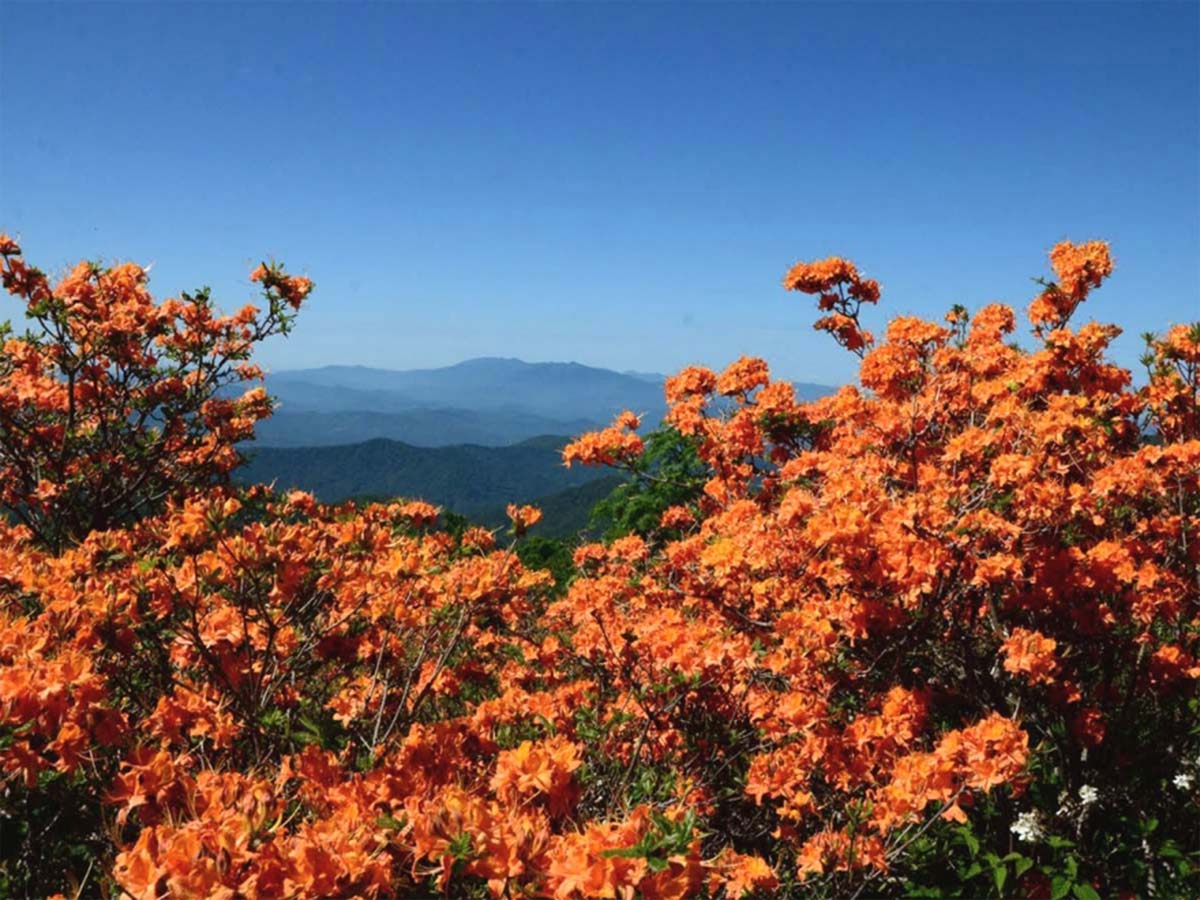
R. calendulaceum along the Appalacian Trail at Engine Gap on Roan Mountain.
On the horizon is Mount Mitchell, the highest point in the Eastern United States.
|

Flame Azaleas Along the Appalachian Trai
|
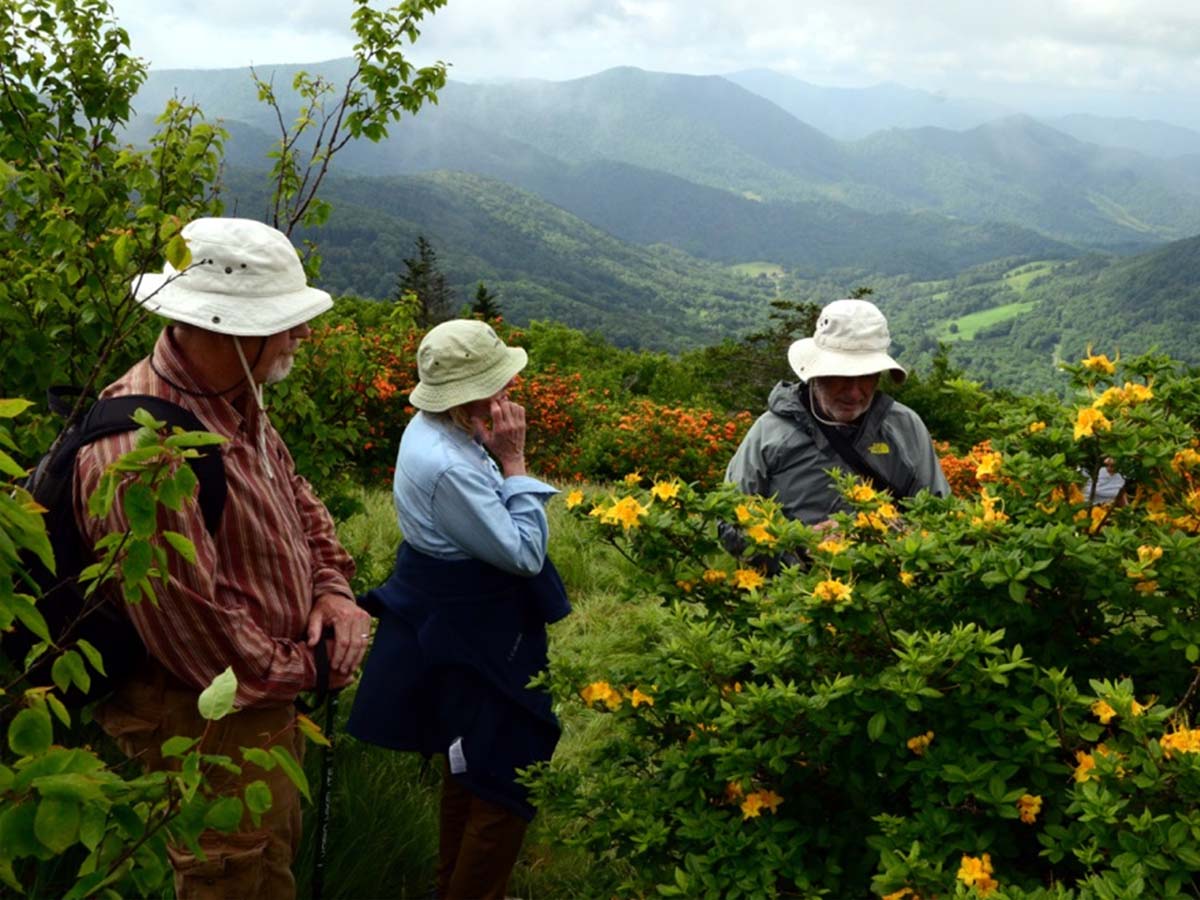
J. Jackson, Lindy Johnson, and George McLellan
|
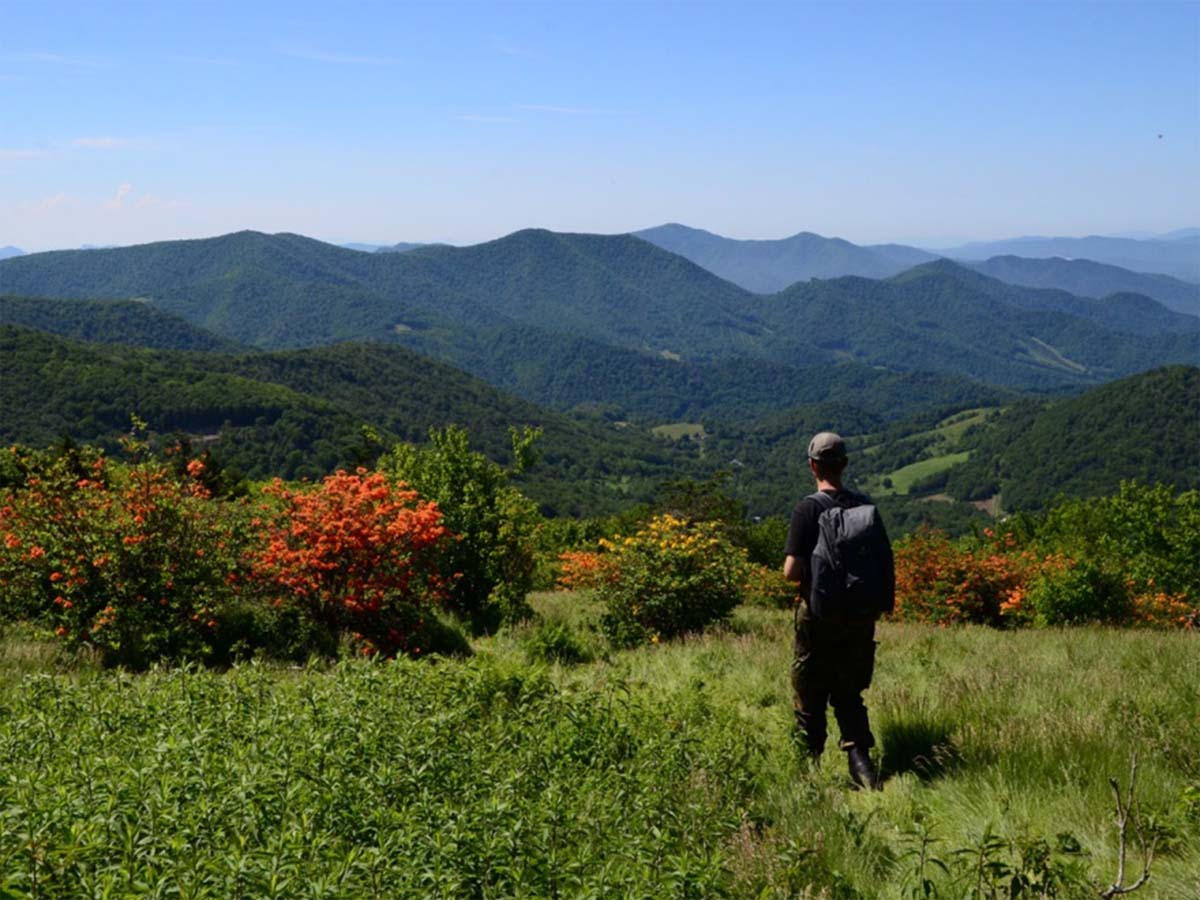 North Carolina Vista at Engine Gap
North Carolina Vista at Engine Gap
|
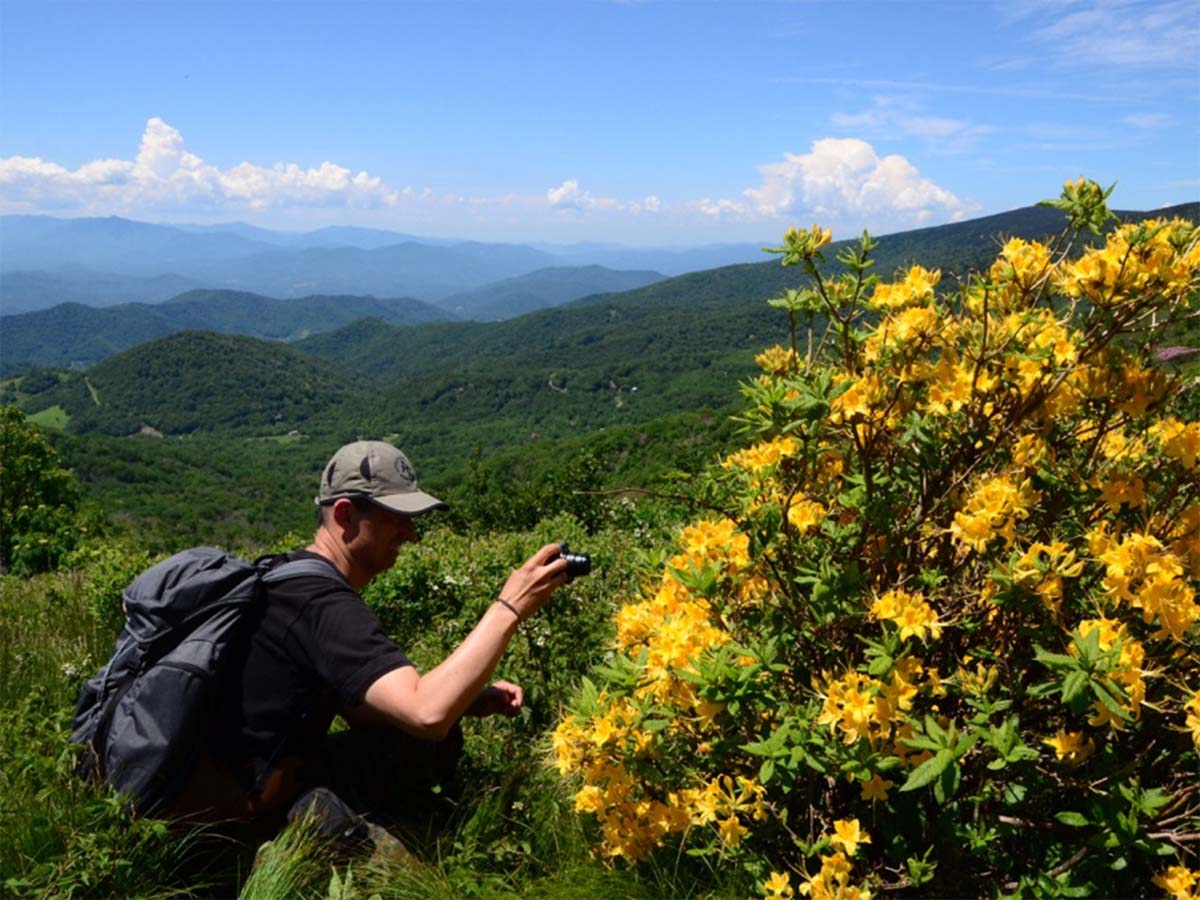
Ralf Bauer Photographs a Yellow Flame Azalea
|
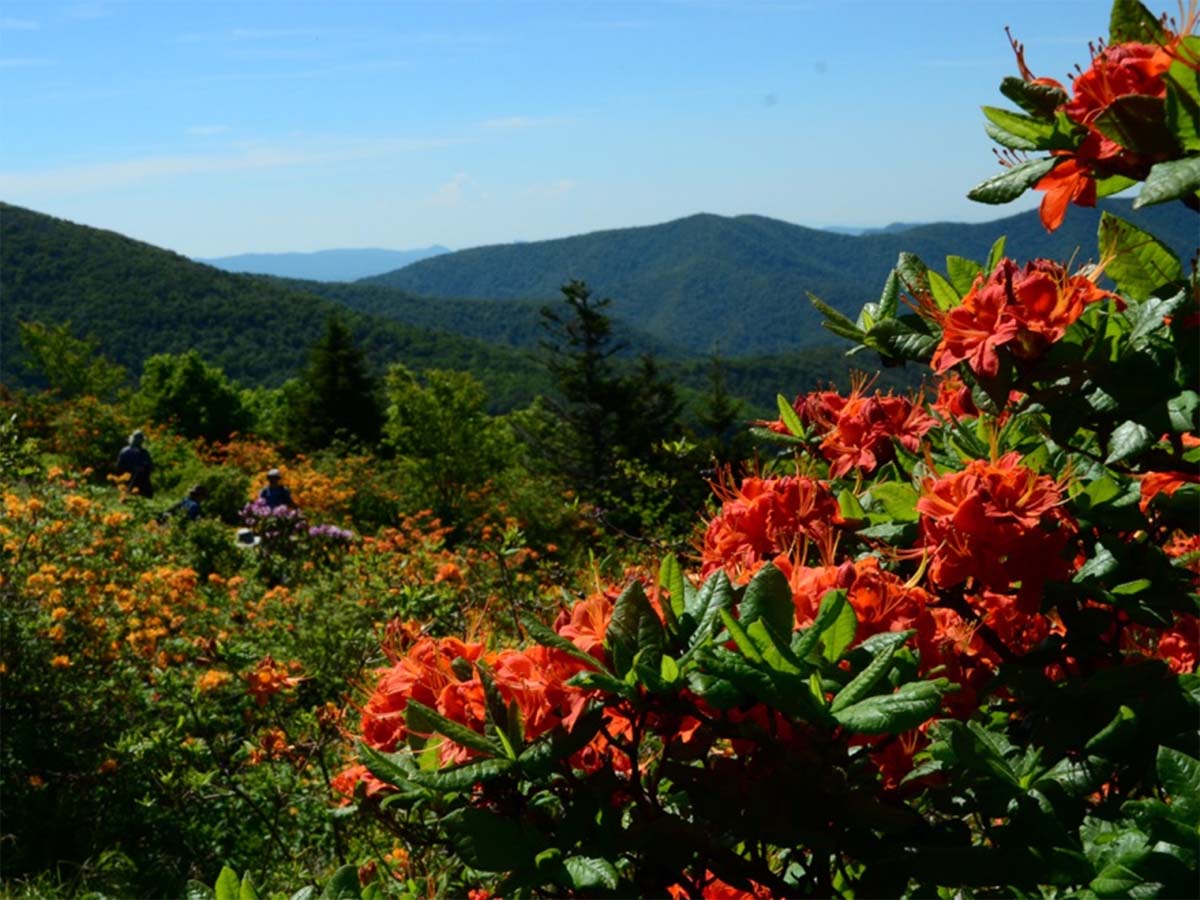
A Red R. calendulaceum
|
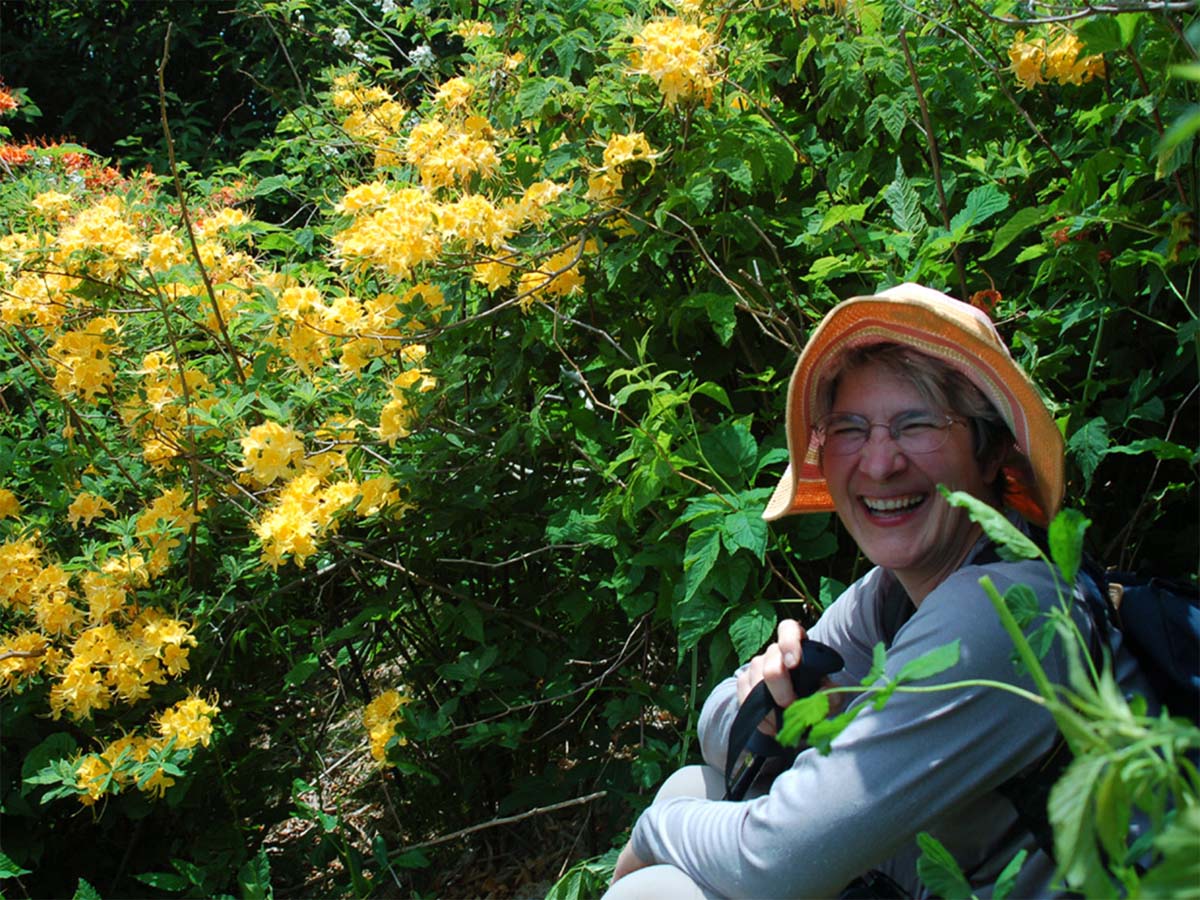
Sally Perkins Admires Azaleas on Jane Bald>
|
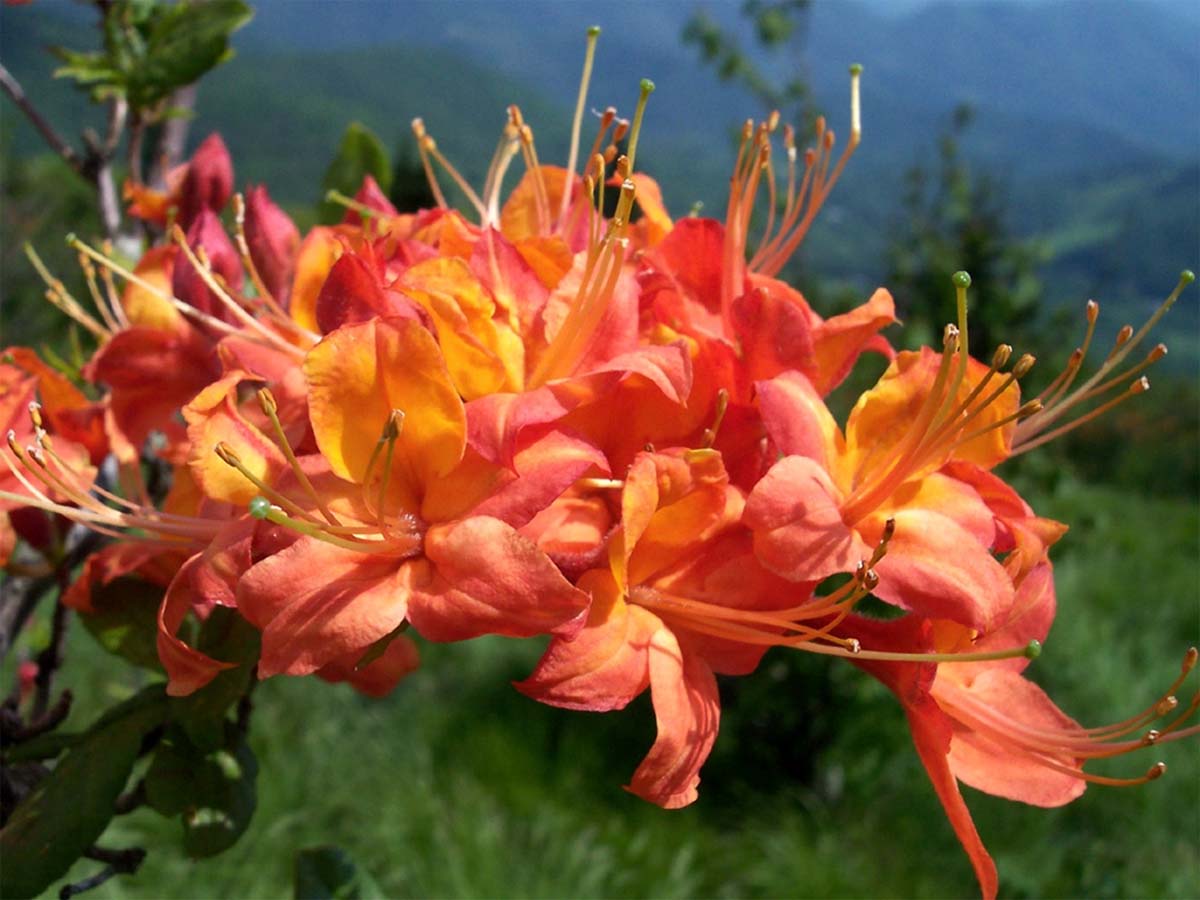
Brilliantly Colored Flame Azalea
|
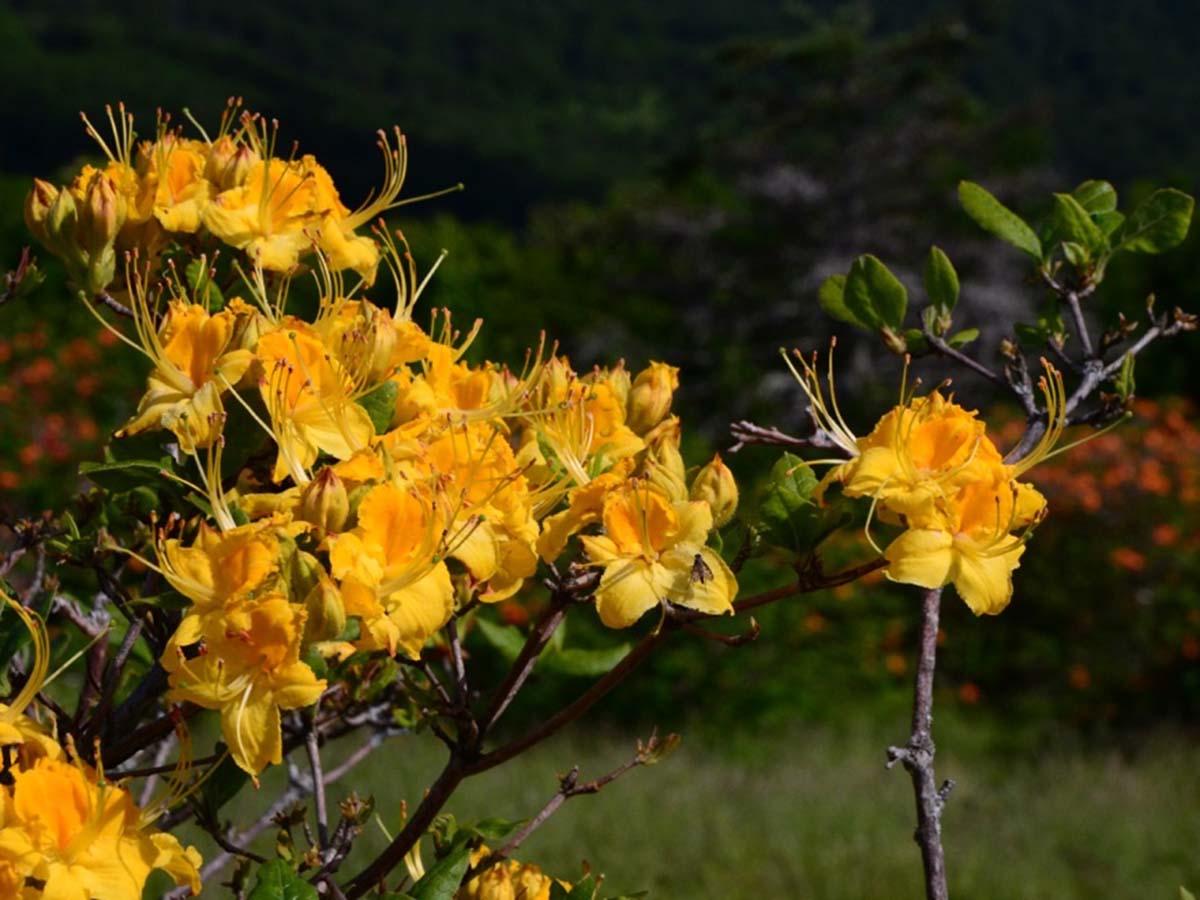
Compact Yellow Selection
|
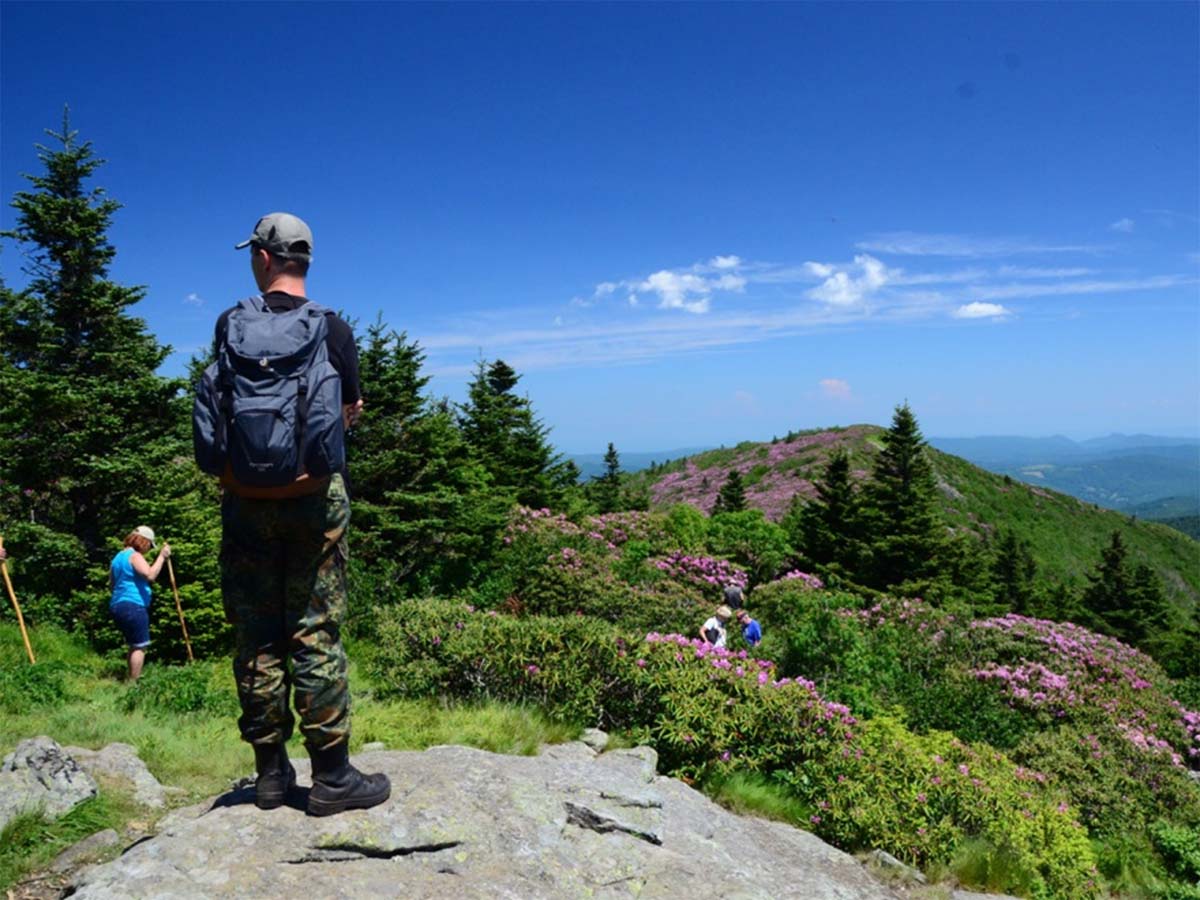
Purple Rhododendrons on Roan Mountain
|
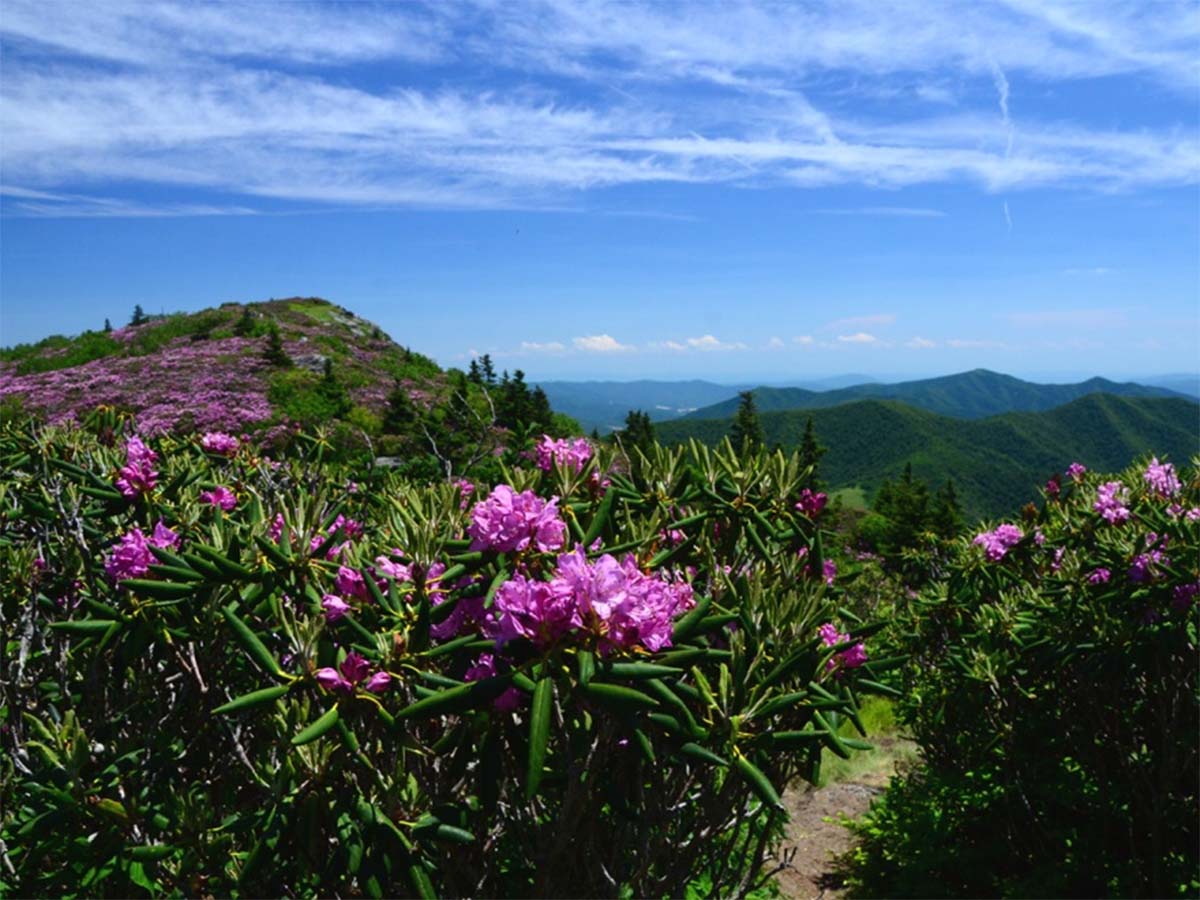
Rhododendrons Along a Side Trail to Grassy Ridge
|
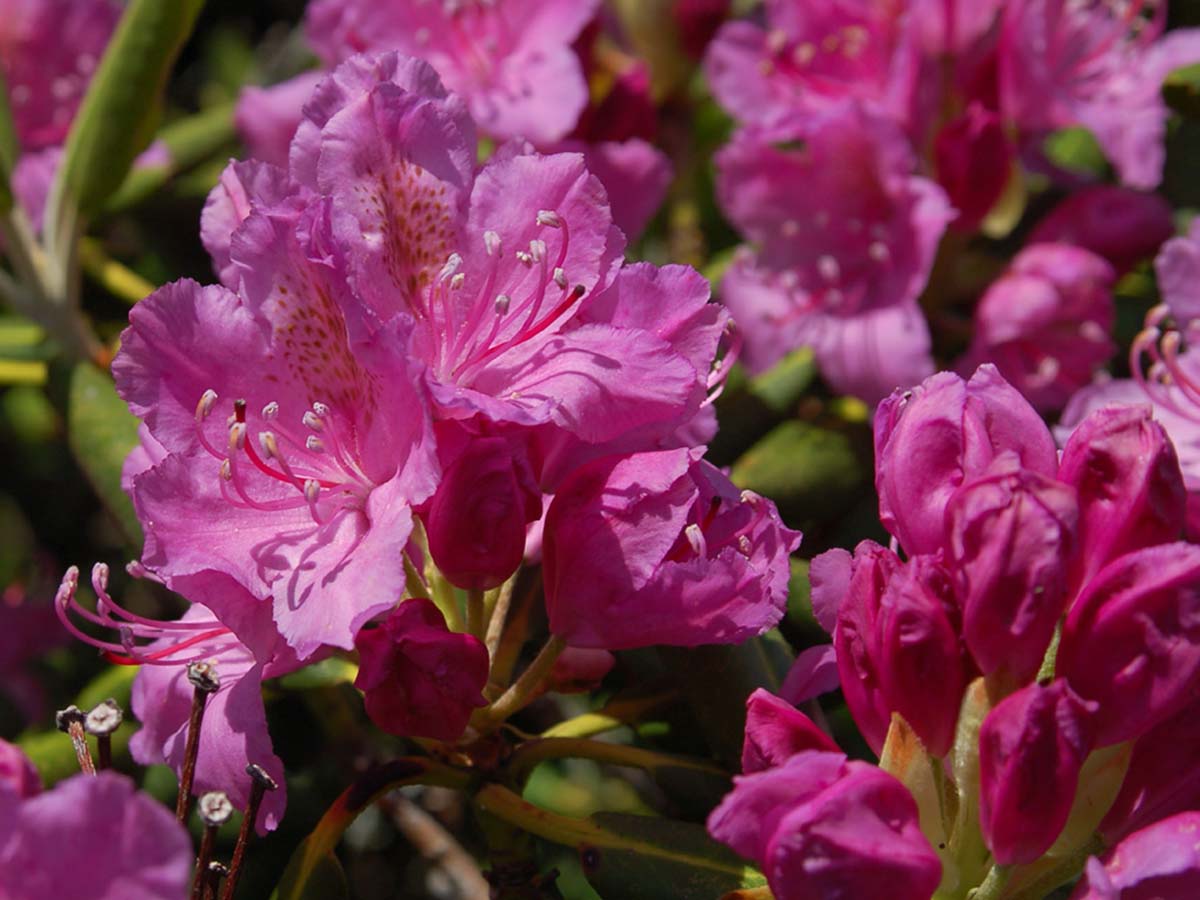
Flowers of R. catawbiense
|
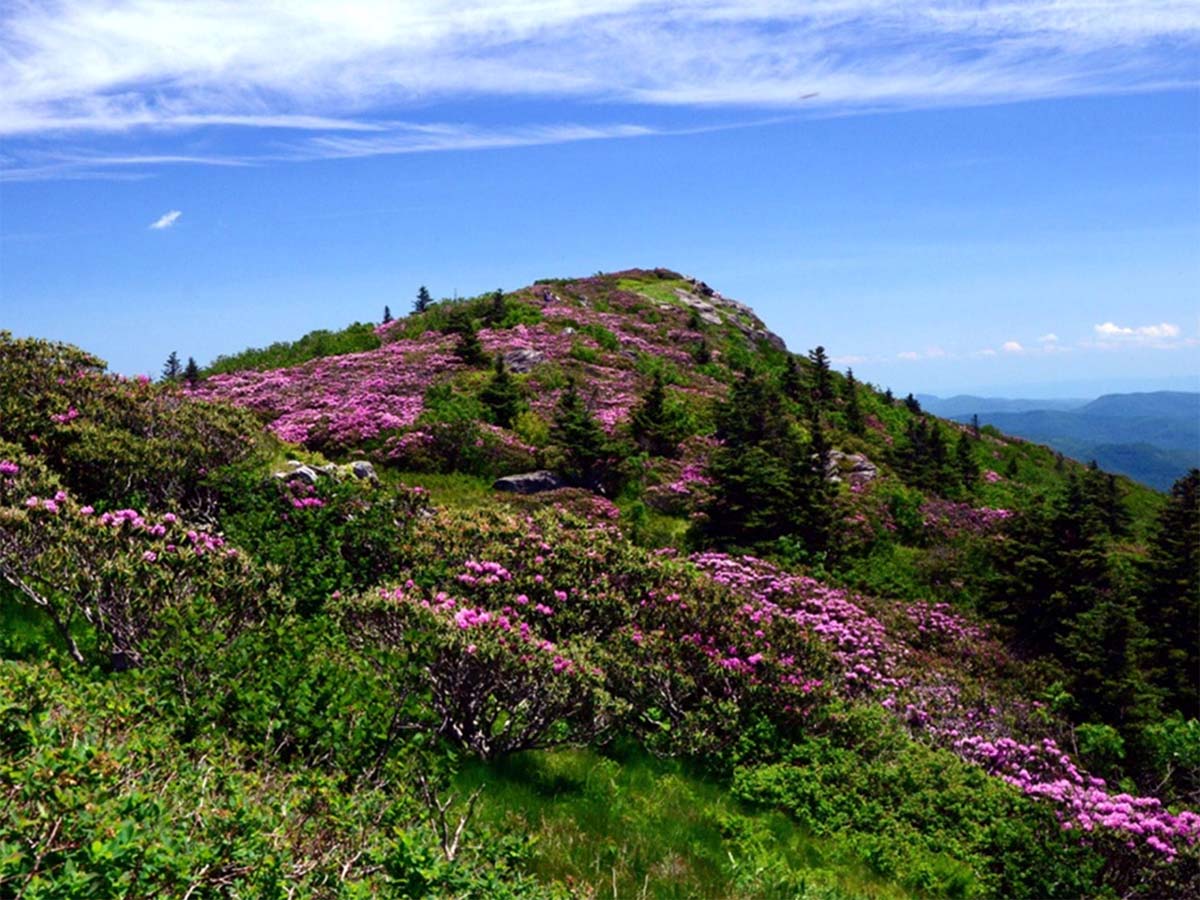
Grassy Ridge Point, the Final Peak on Roan
|
Some Color Variations of R. calendulaceum
The salient feature of R. calendulaceum is surely its fiery flower color in shades of yellow, orange, or red. Orange is the most common with pure red being rare, but one should not assume that there are only three color forms of this species. The range is a continuum from light lemon yellow, through deeper butter yellow and rich gold, to innumerable shades and intensities of orange, to orange-red, brick red, and even scarlet. Some plants have flowers of apricot, peach, or salmon. Others may be blends of several colors, possibly brushed with secondary pigments like pink or red.
In addition to the corolla color, the blotch of R. calendulaceum is a totally independent hue. Some flowers have broad areas of intense gold, orange, or yellow that can completely fill the dorsal petal and even extend into adjacent petals. In some plants, the blotch may be nearly the same color as the corolla and barely noticeable. The pigment in the blotch is usually more intense than the base corolla color, noticeably opaque, and sometimes textured.
Like many native azaleas, the buds of R. calendulaceum are often a deeper color than the open flowers, but not always. We have noticed that some flame azaleas have a tendency for the flower color to deepen with age, a transition that can be very startling at times. Flowers on these plants may open clear yellow, but soon deepen to shades of orange or even deep red as they complete their color shift. At times, the full range of colors can be present on the same plant, or even within the same flower truss. We suspect the color shift is affected by light since flowers on a plant that open in shade seem to show less color change than those in brighter locations.
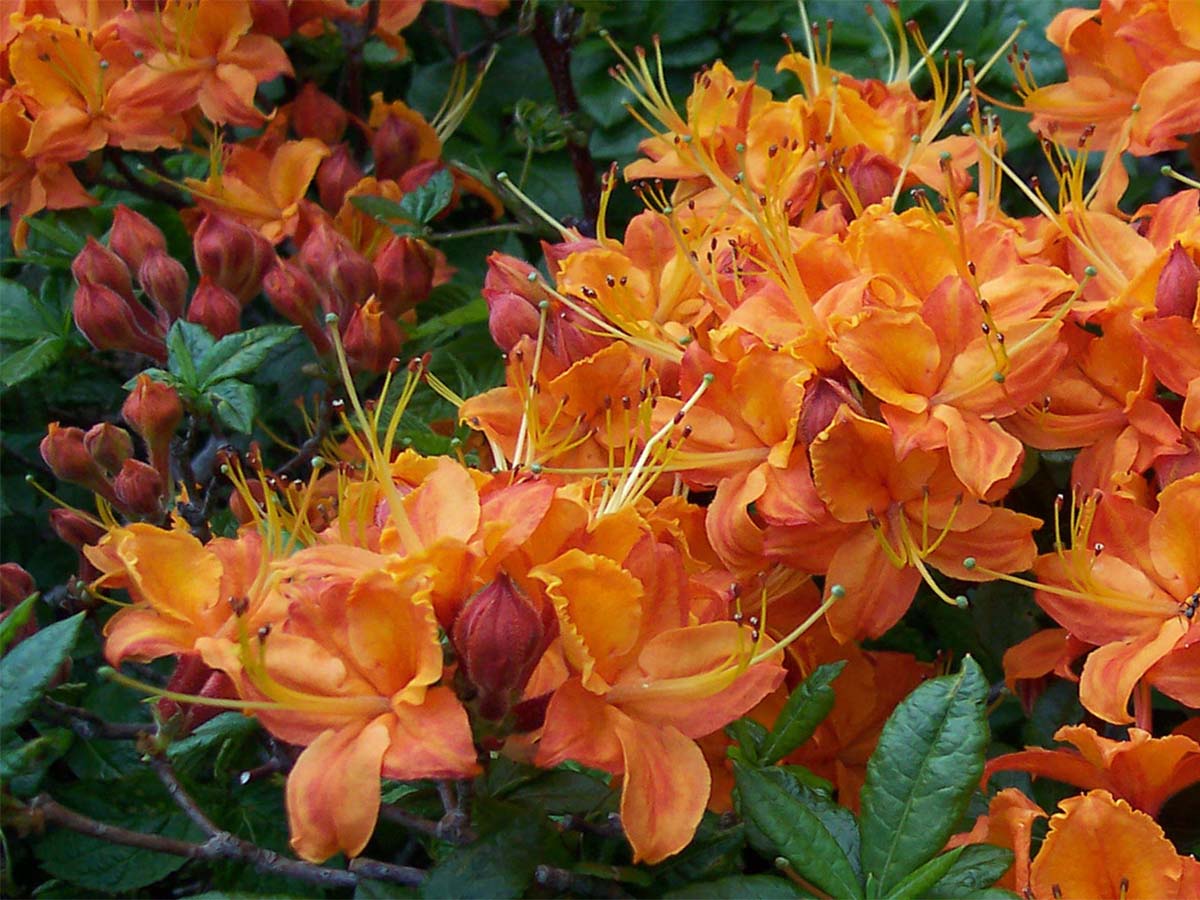
Orange with Yellow Stamens
|
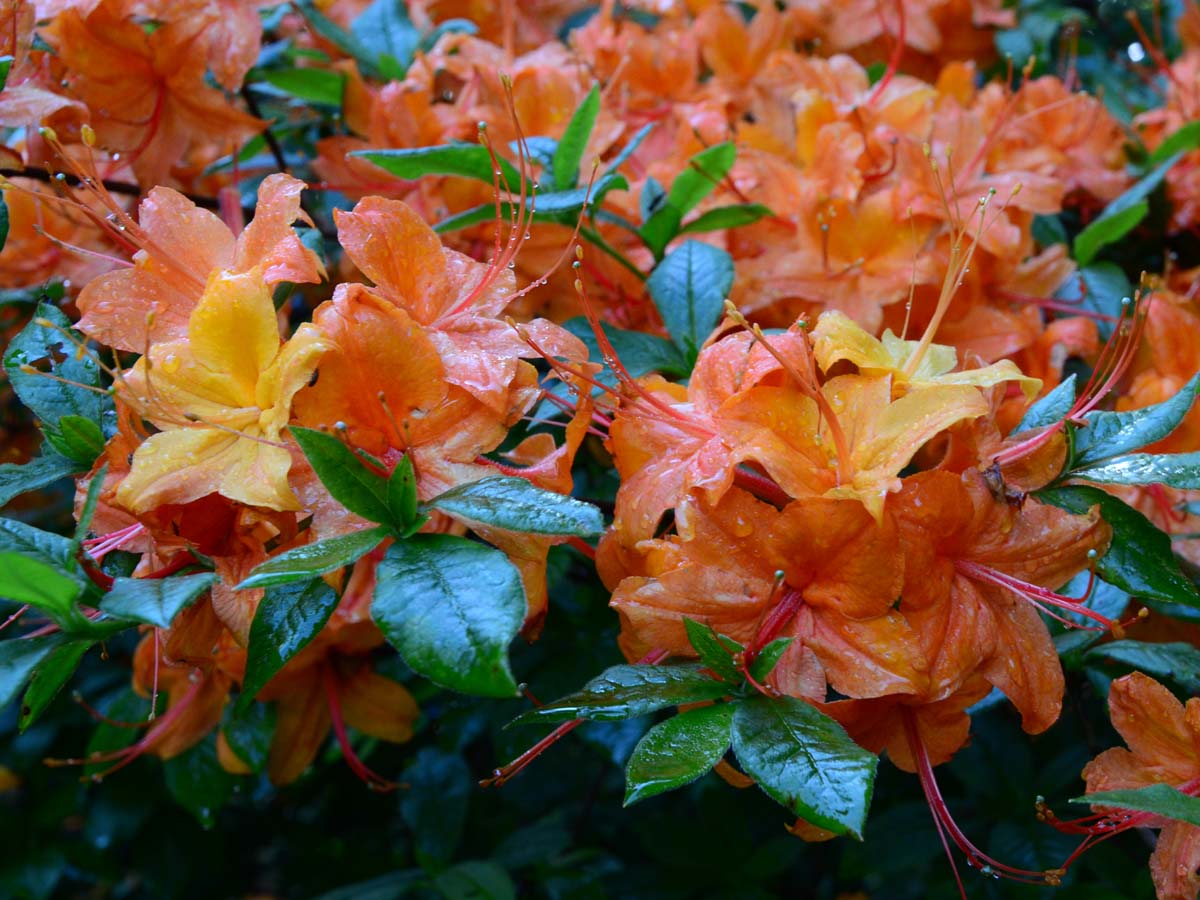
Flowers Open Yellow & Change to Orange
|
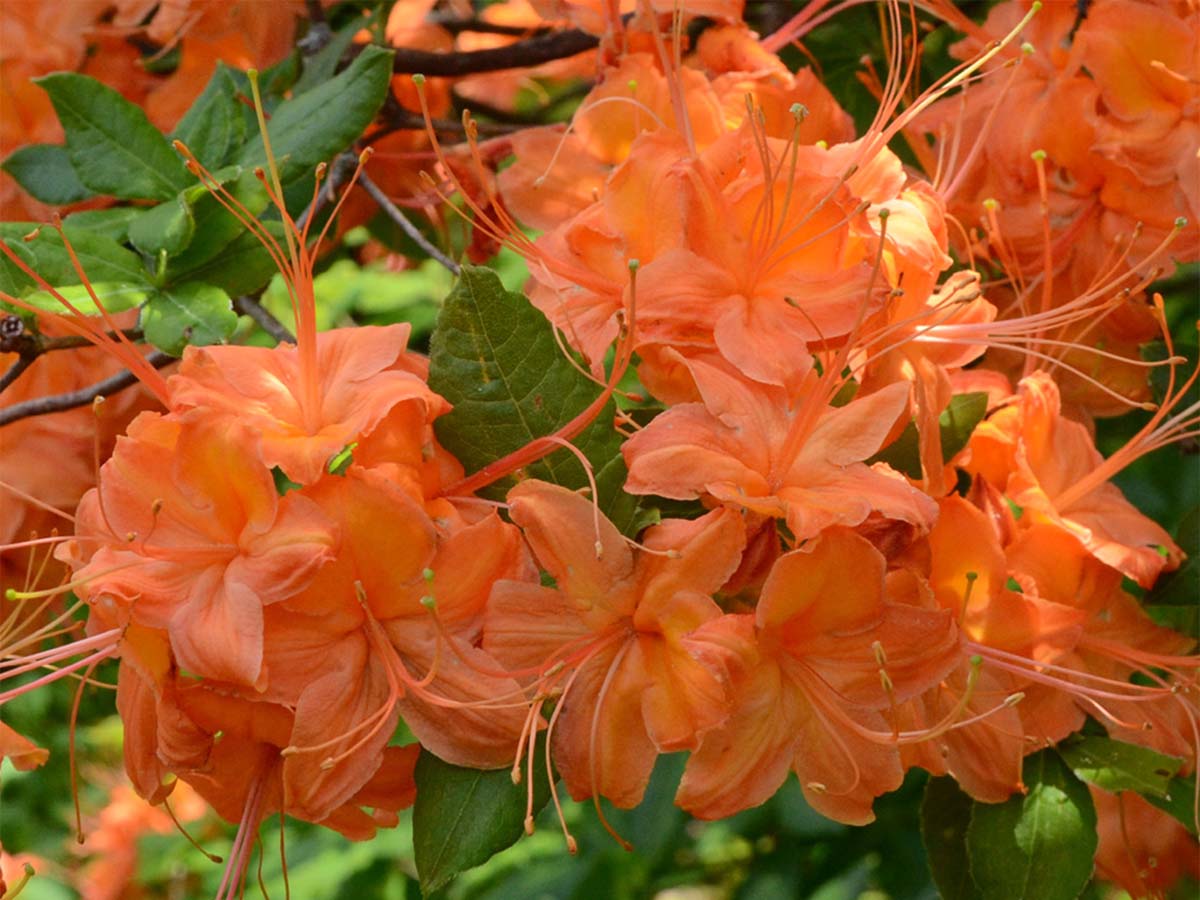
Deep Orange with Orange Stamens
|
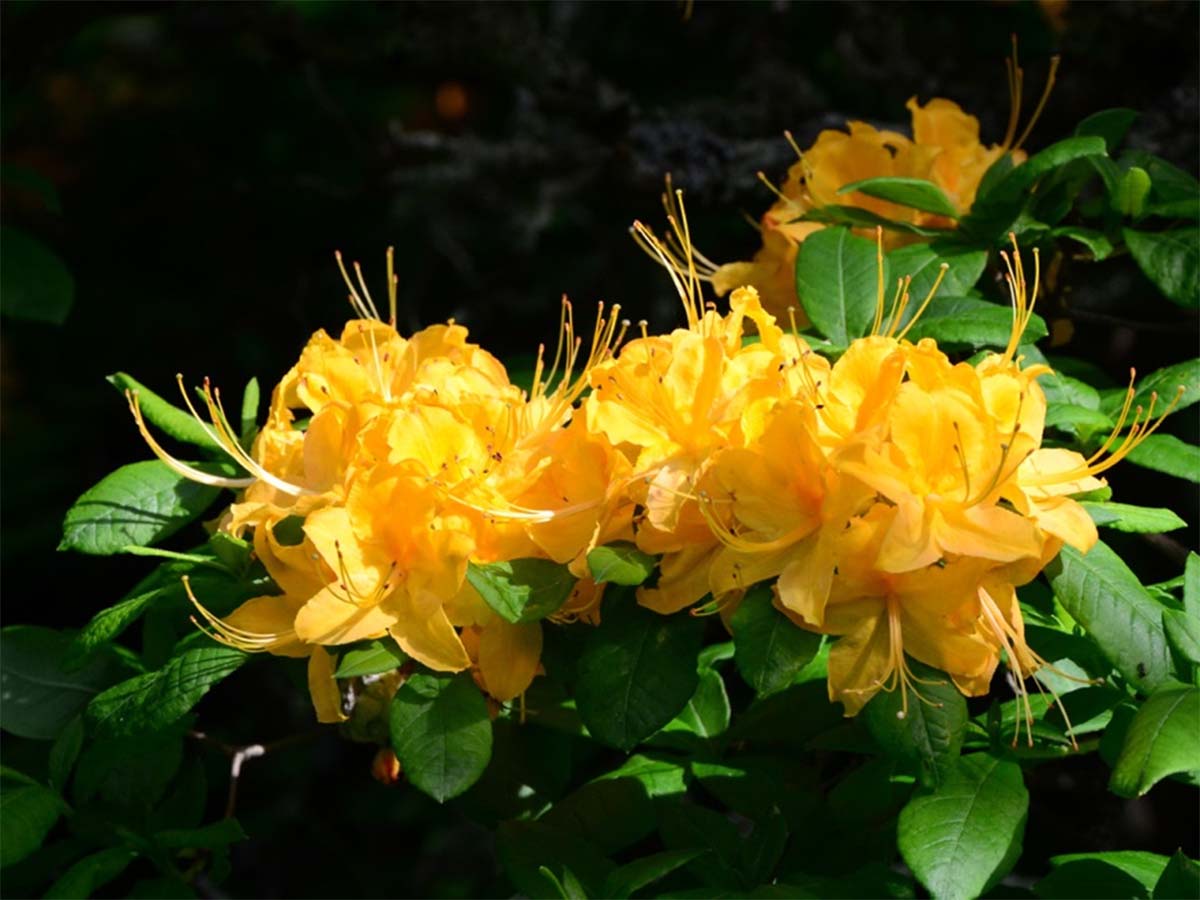
Gold
|
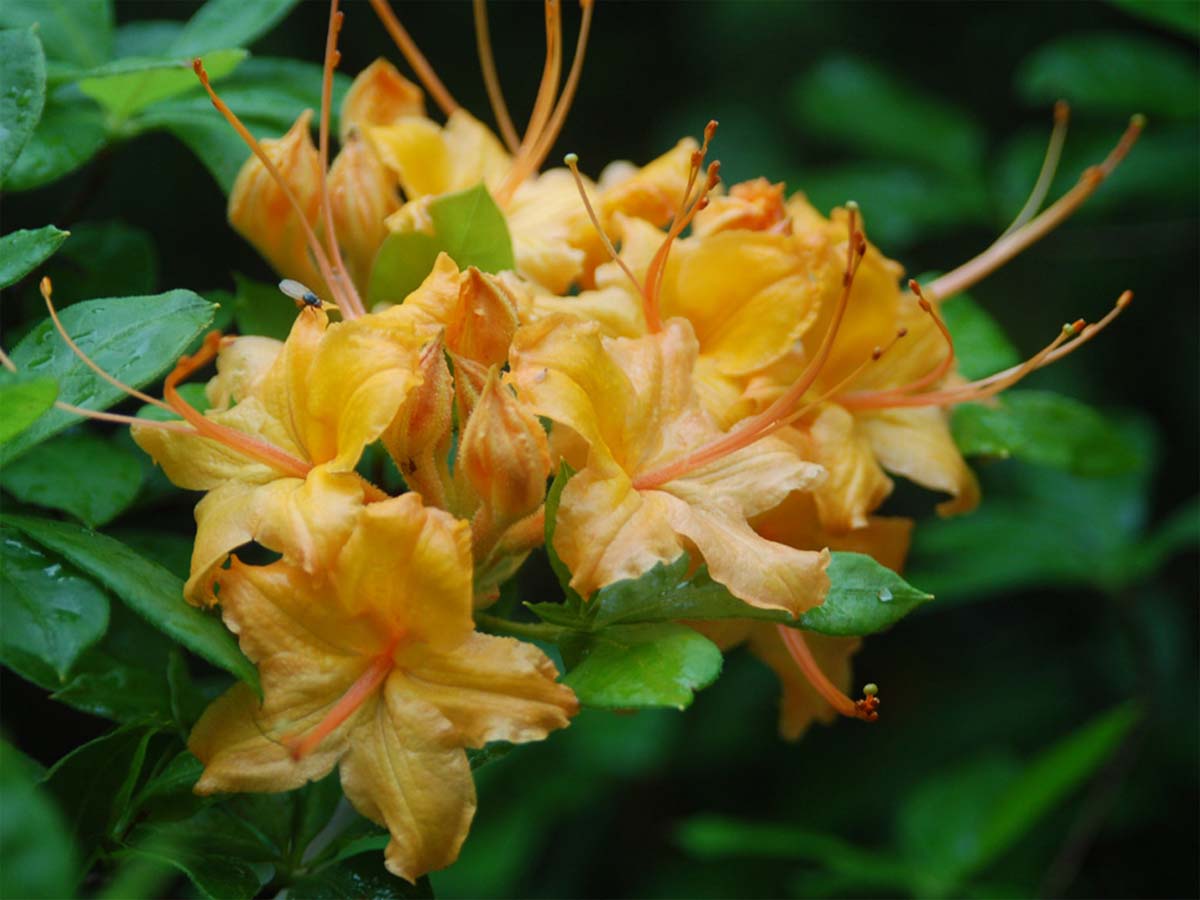
Gold with Orange Stamens
|
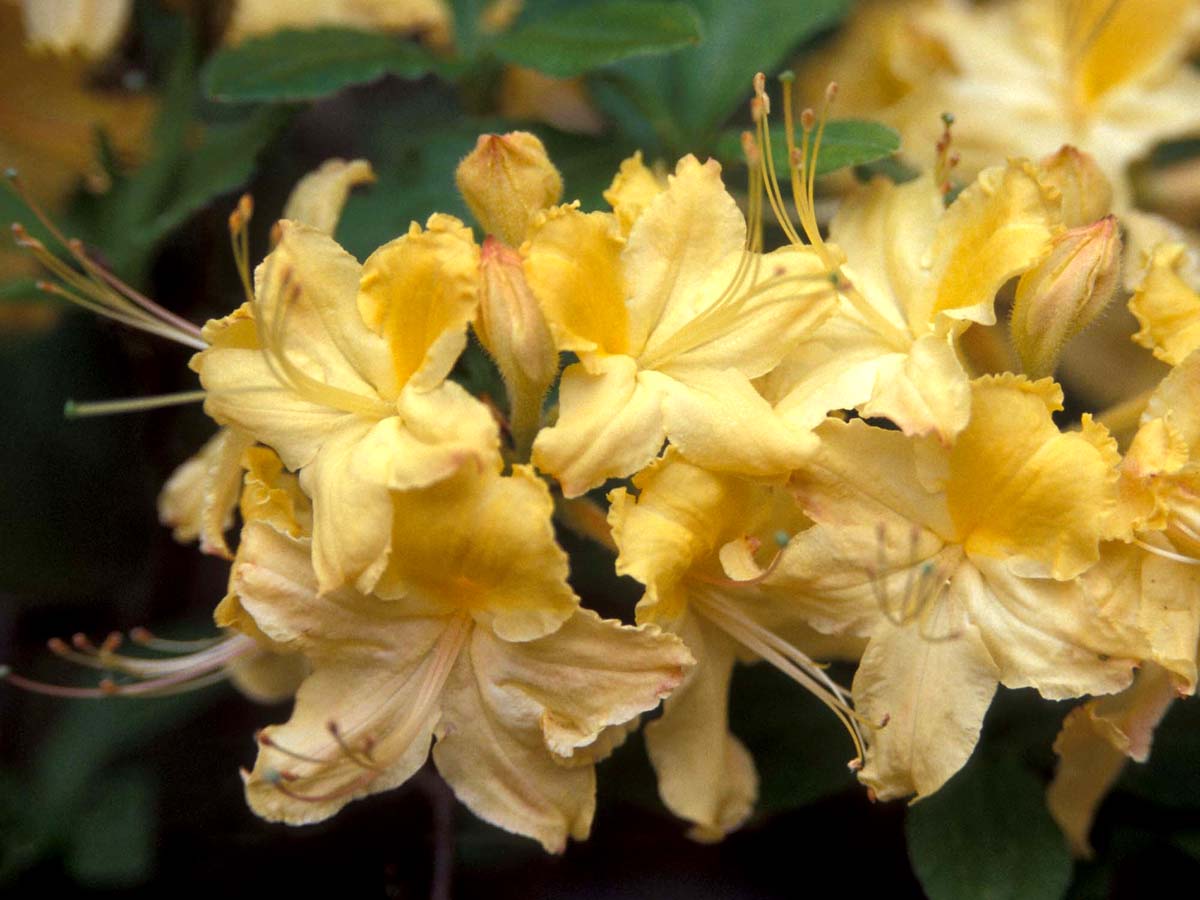
Light Yellow with Gold Blotch
|
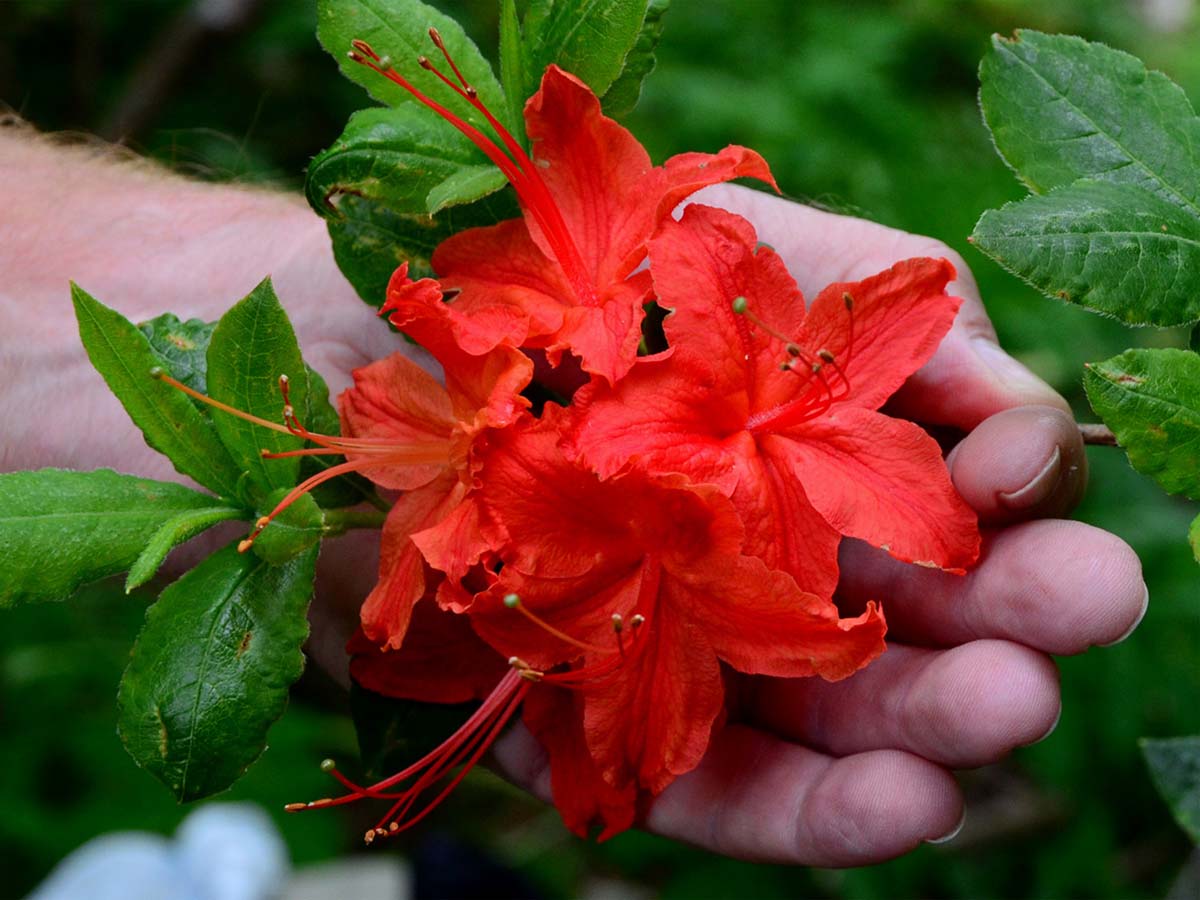
Large Deep Red
|
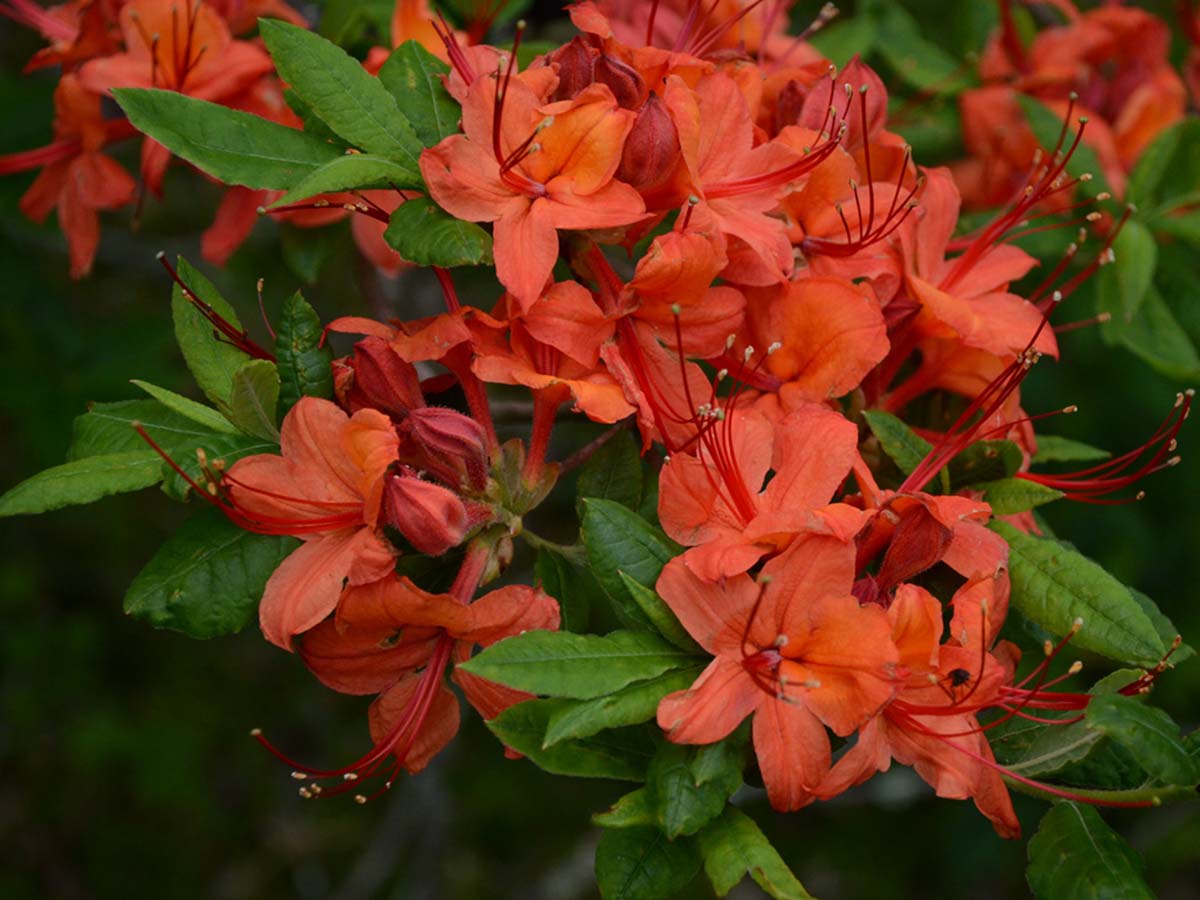
Light Red
|
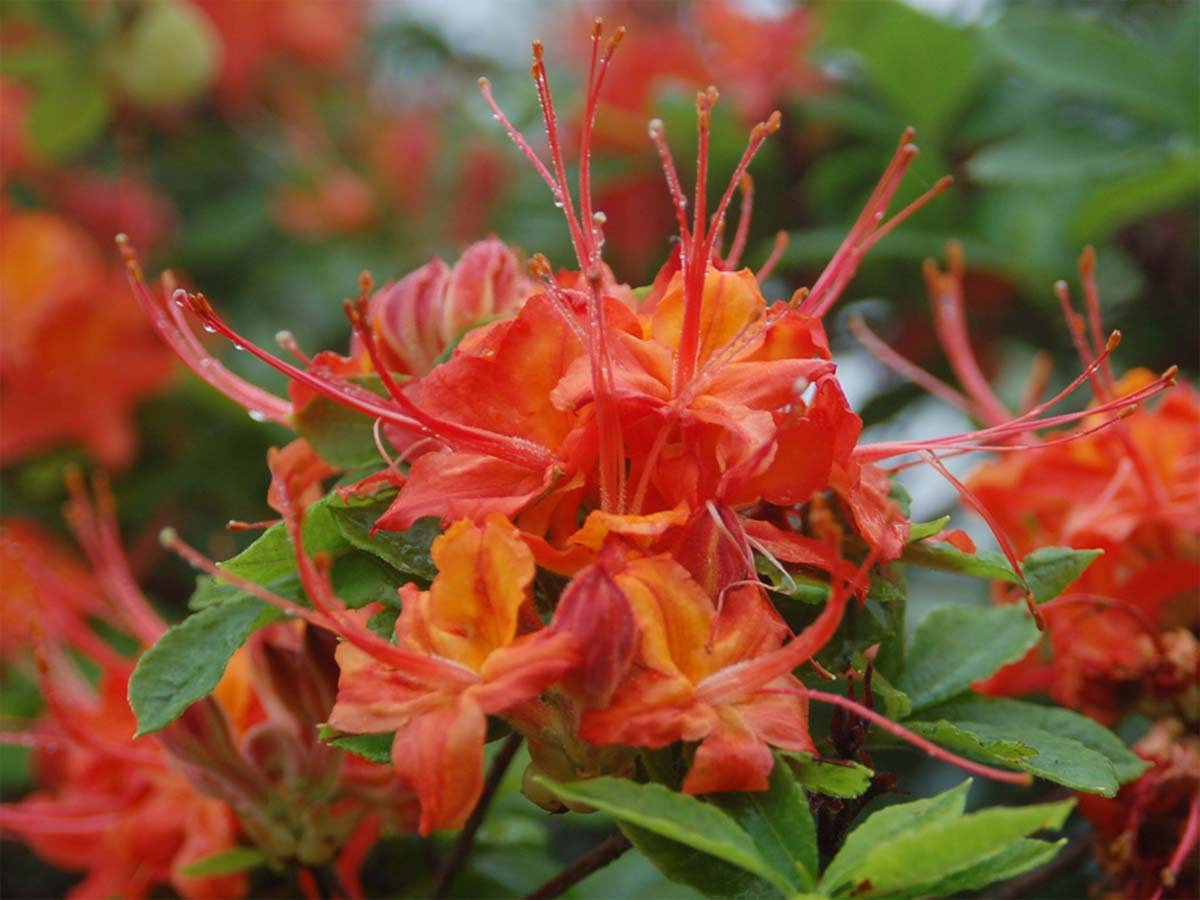
Red with Gold Blotch
|
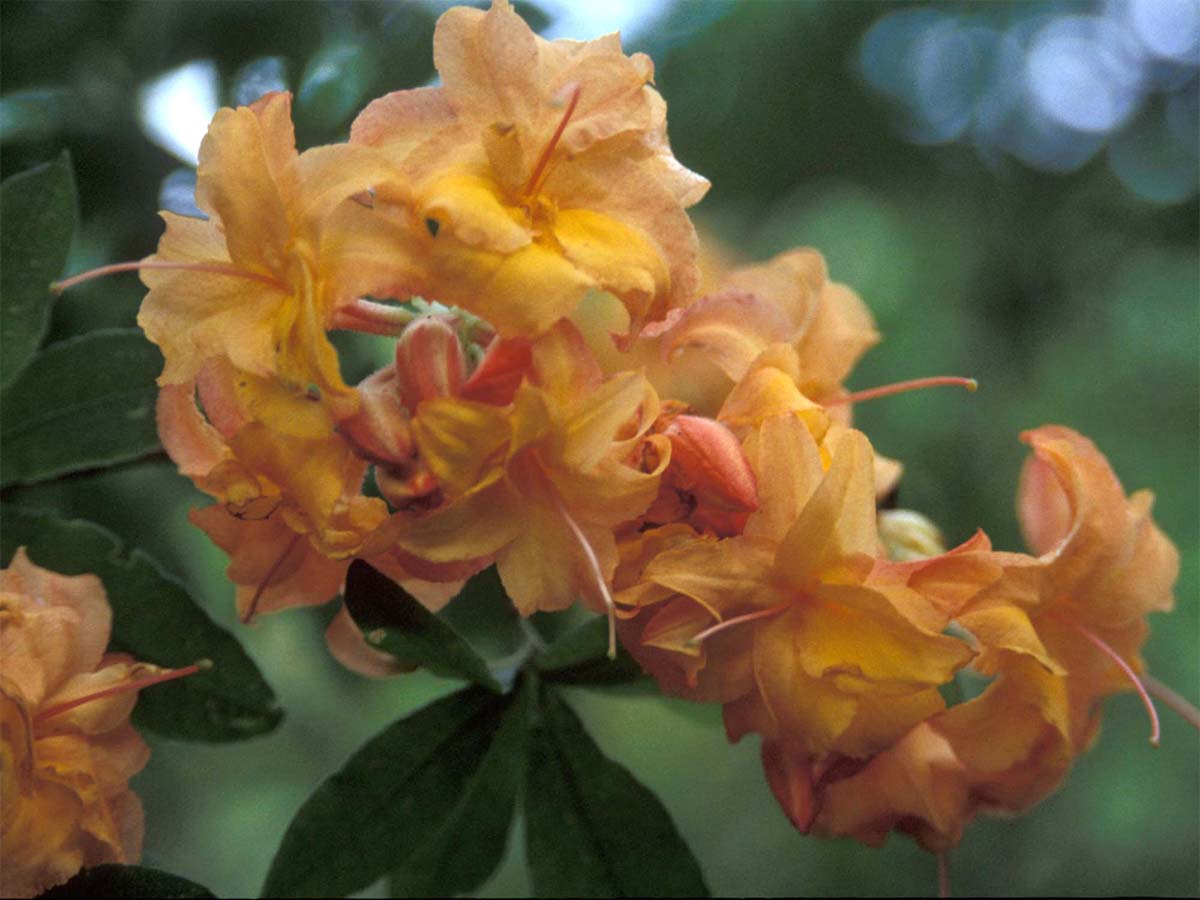
Double Orange
|
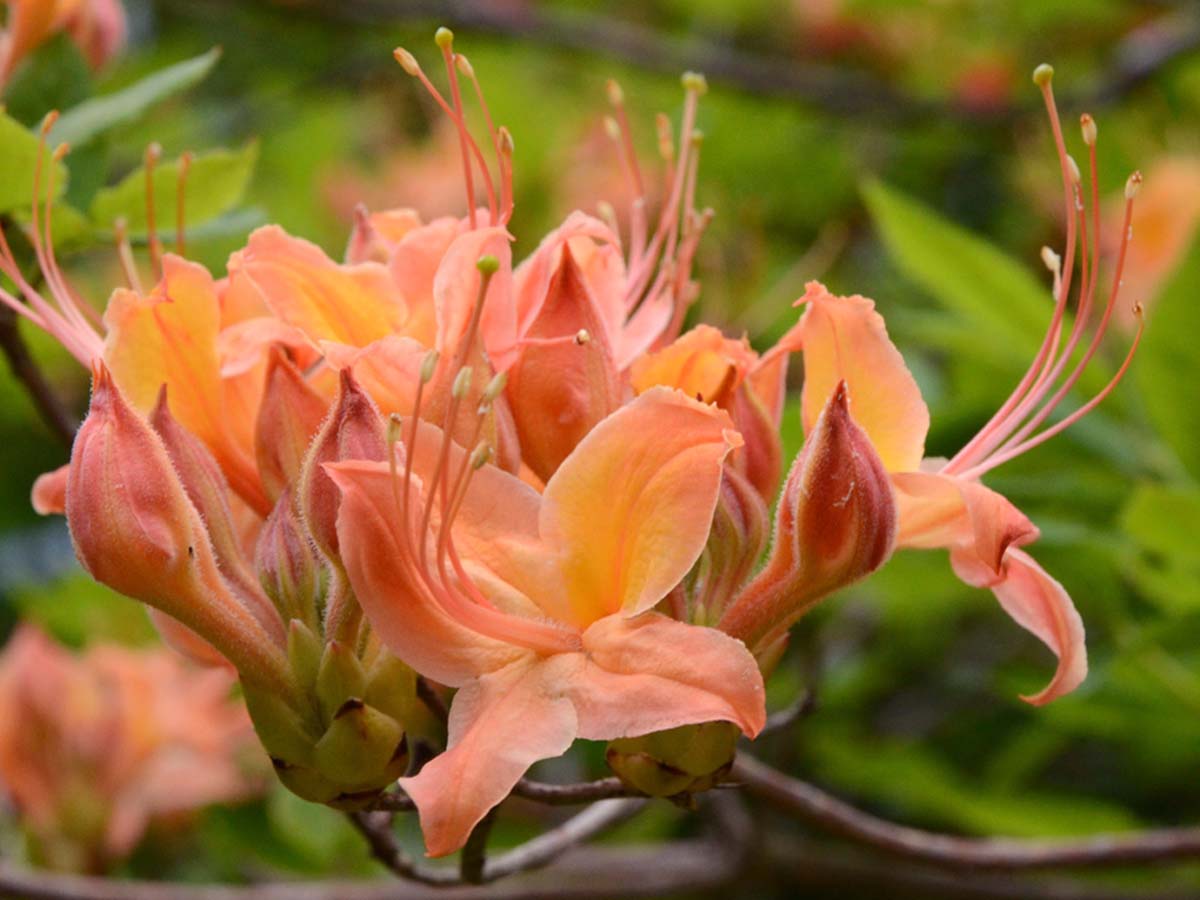
Apricot
|
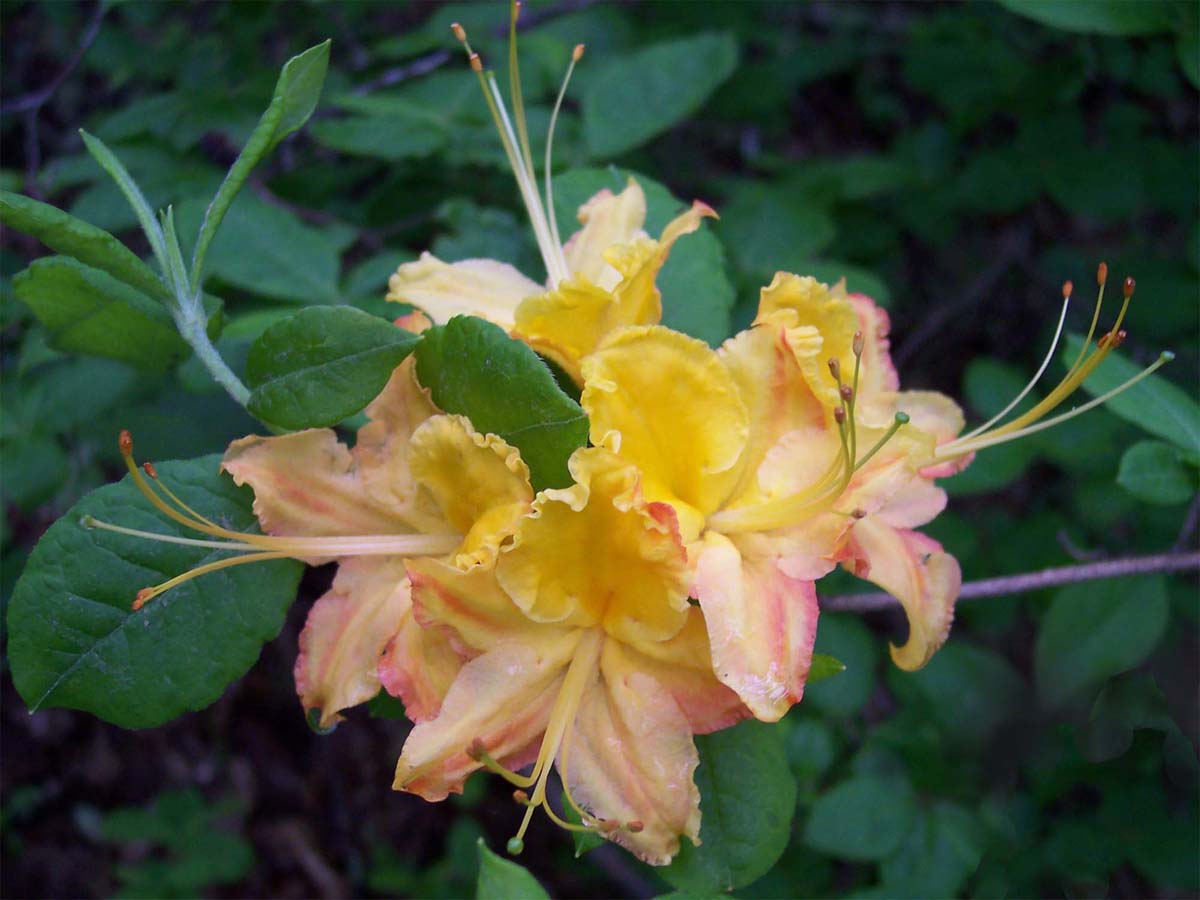
Yellow with Pink Blush
|
Rhododendron luteum
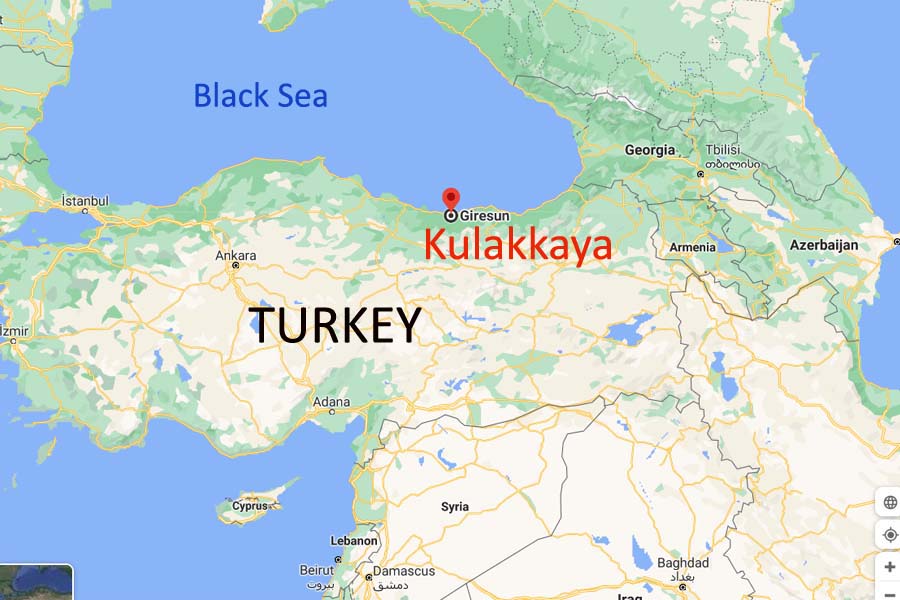 Throughout much of Europe, the yellow deciduous azalea known as Rhododendron luteum has almost become naturalized. One might assume it was a native plant. The tall, spreading shrub covers itself with yellow flowers and their strong fragrance seems to perfume the entire garden. The plants seem to be rather uniform with slight variations in flower shape and growth habit. Blossoms can range from light greenish yellow to deep yellow, and even approaching gold. Most flowers have a deeper gold blotch although I have seen one that was decidedly green.
Throughout much of Europe, the yellow deciduous azalea known as Rhododendron luteum has almost become naturalized. One might assume it was a native plant. The tall, spreading shrub covers itself with yellow flowers and their strong fragrance seems to perfume the entire garden. The plants seem to be rather uniform with slight variations in flower shape and growth habit. Blossoms can range from light greenish yellow to deep yellow, and even approaching gold. Most flowers have a deeper gold blotch although I have seen one that was decidedly green.
In late May of 2007, Dr. Hans Eiberg traveled to the Caucasus and Eastern Europe for two weeks to study some of the rhododendrons native to that area including R. caucasicum, R. smirnowii, R. ungernii, R. ponticum, and R. luteum. He has kindly allowed us to use some of his photos of R. luteum to show that even species we thought were uniform may have striking variations in the wild.
R. luteum is especially prolific on the Northeast coast of Turkey between 500 to 2500 meters in elevation (1600 to 8200 ft). Hans discovered some very rare forms near Kulakkaya including R. luteum 'Orange' and a bicolor form that was near white but with a gold blotch. Obviously, this deciduous azalea has a much greater color range than we have seen in the past. He has raised seedlings from the orange form which are also orange. Wide variability of plants in the wild is generally true so that is why a single representative of a species rarely enough in any collection.
|
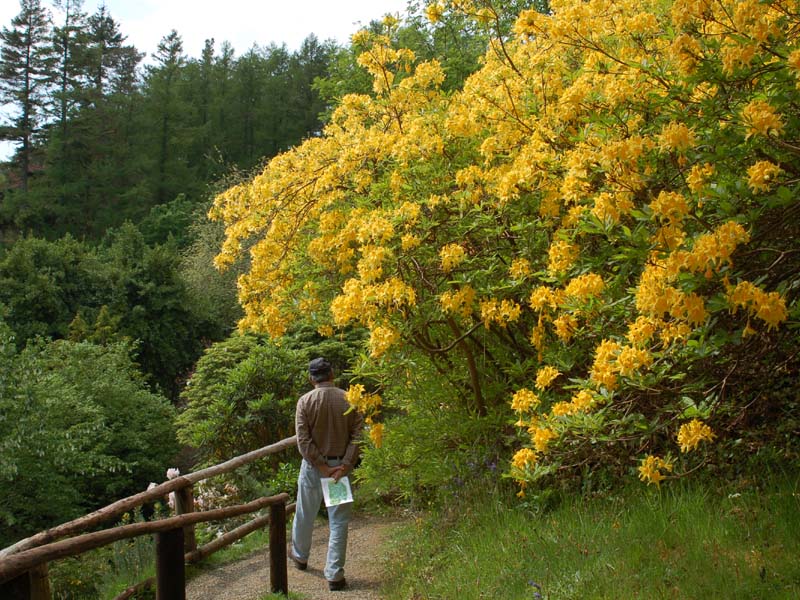
Large R. luteum Plants in a Scottish Garden.
|
|
R. luteum in a Garden Situation
|
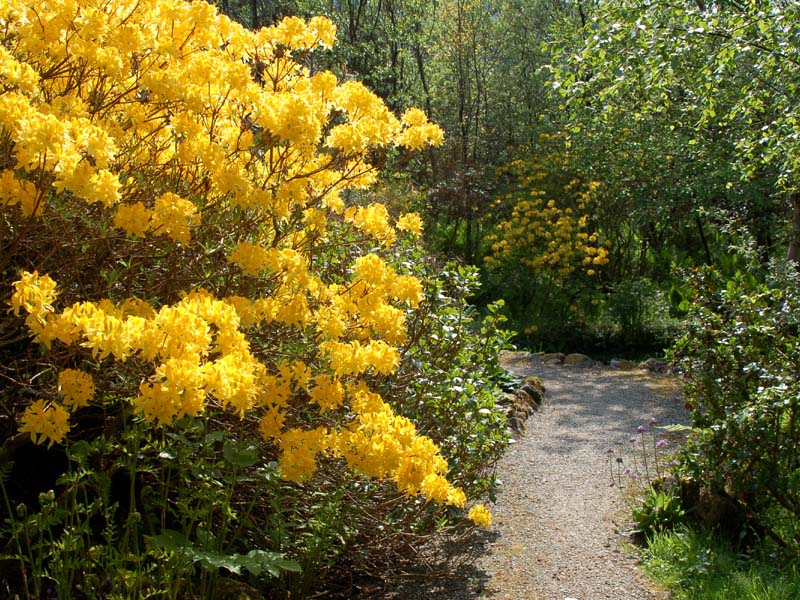
Fragrant R. luteum along a Garden Path
Photo by Don Hyatt
|
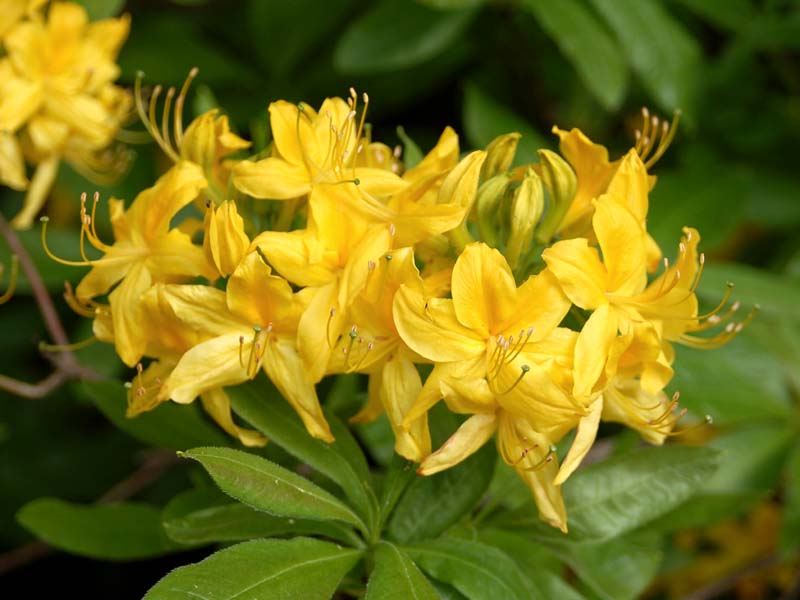
Large Yellow Flowers - Wide Petals
Photo by Don Hyatt
|
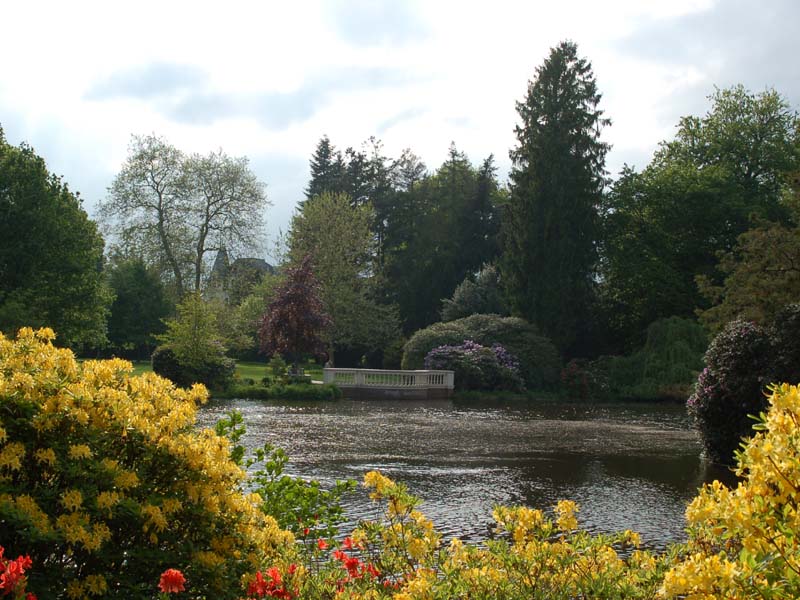
R. luteum in a German Garden
Photo by Don Hyatt
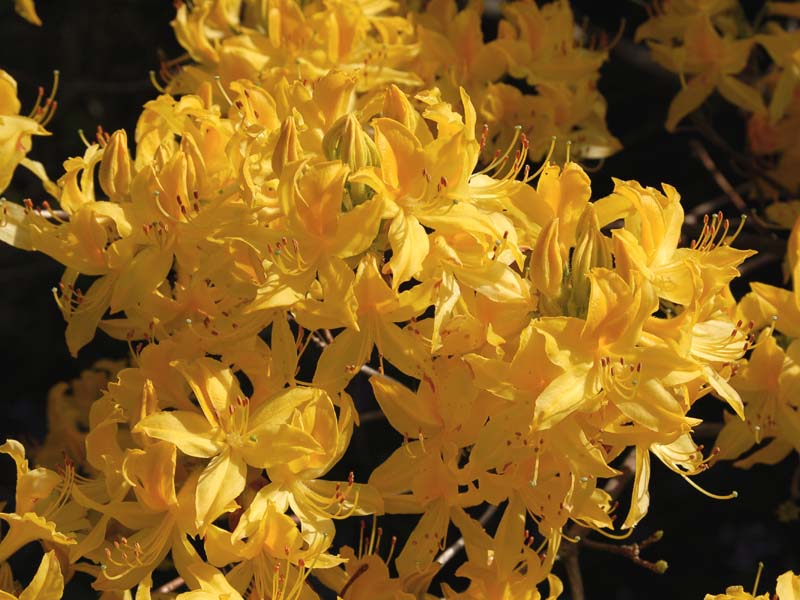
Deep Gold Form - Narrow Petals
Photo by Don Hyatt
|
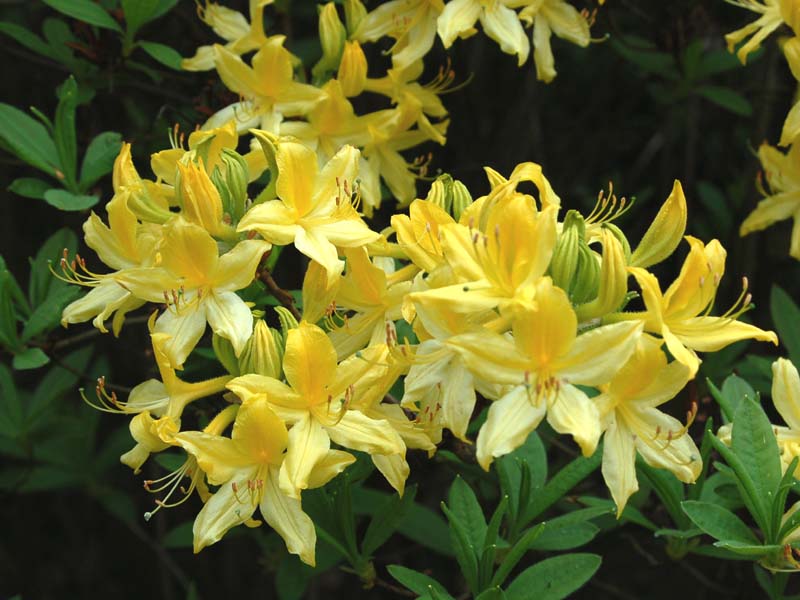
Lighter Yellow with a Gold Blotch
Photo by Don Hyatt
|
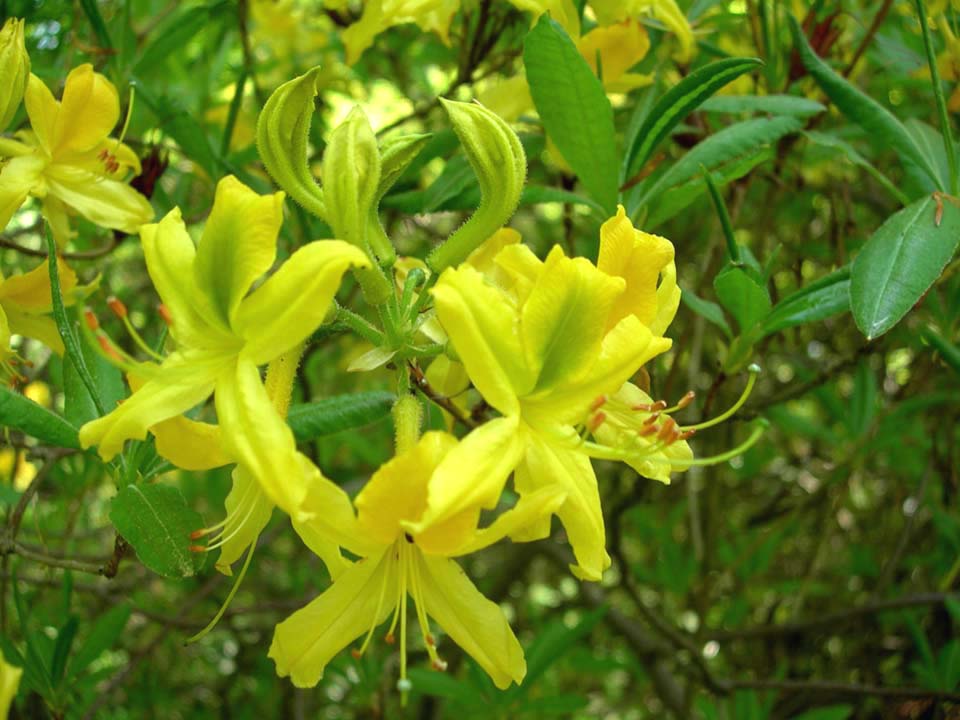
Greenish Yellow with a Green Blotch
Photo by Don Hyatt
|
R. luteum in the Wild - All photos by Hans Eiberg
|
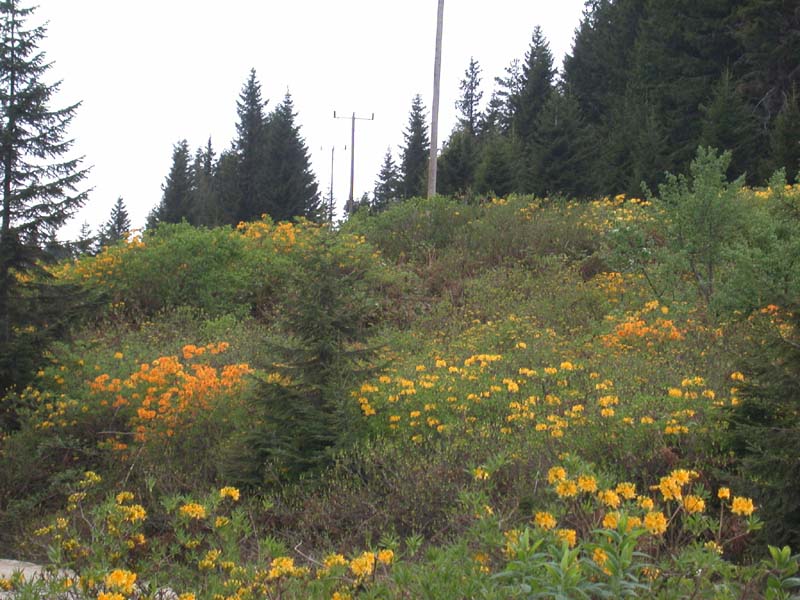
Hillside of diverse forms of R. luteum in the Wild
Photo by Hans Eiberg
|
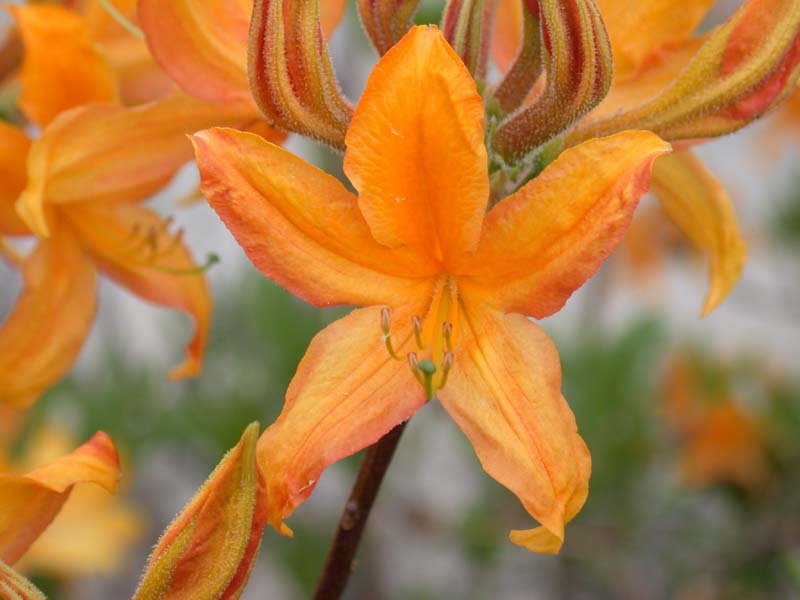
R. luteum 'Orange' discovered near Kullakaya, Turkey
Photo by Hans Eiberg
|
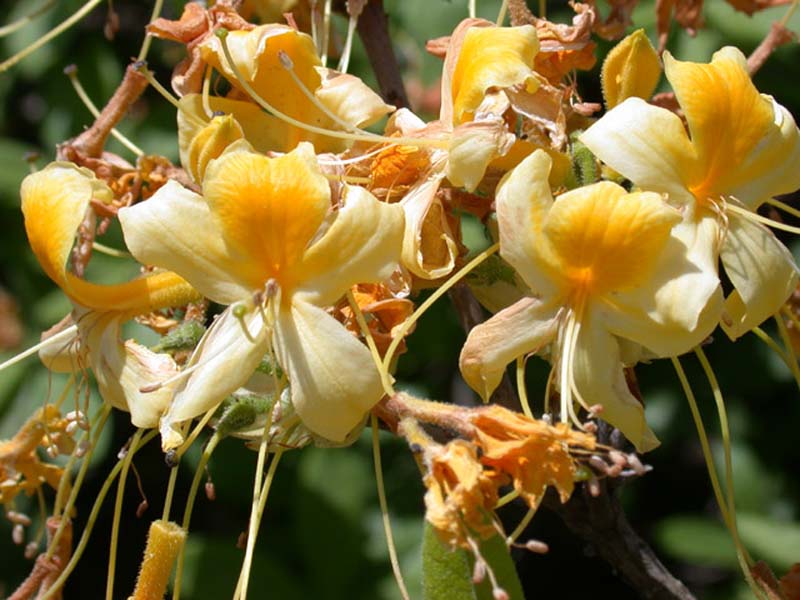
Near White with Gold Blotch seen in the Wild
Photo by Hans Eiberg
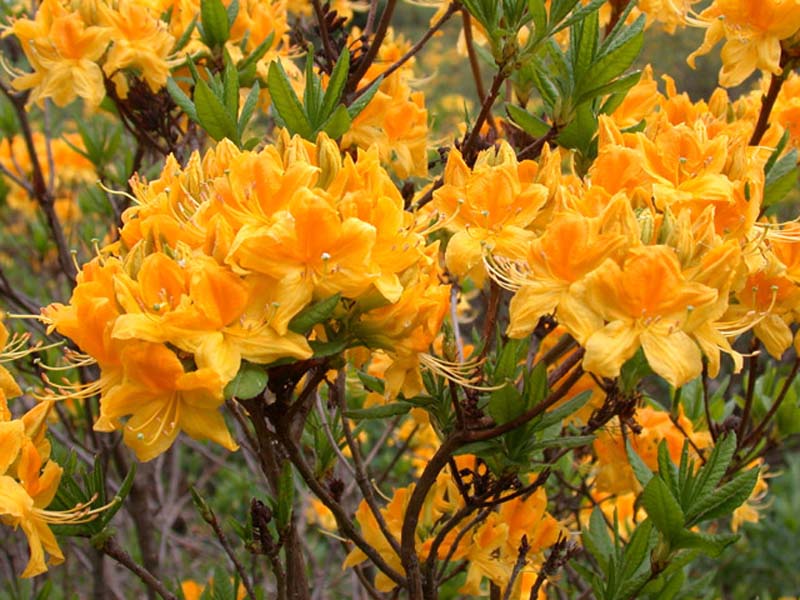
Superior Deep Gold in the Wild
Photo by Hans Eiberg
|
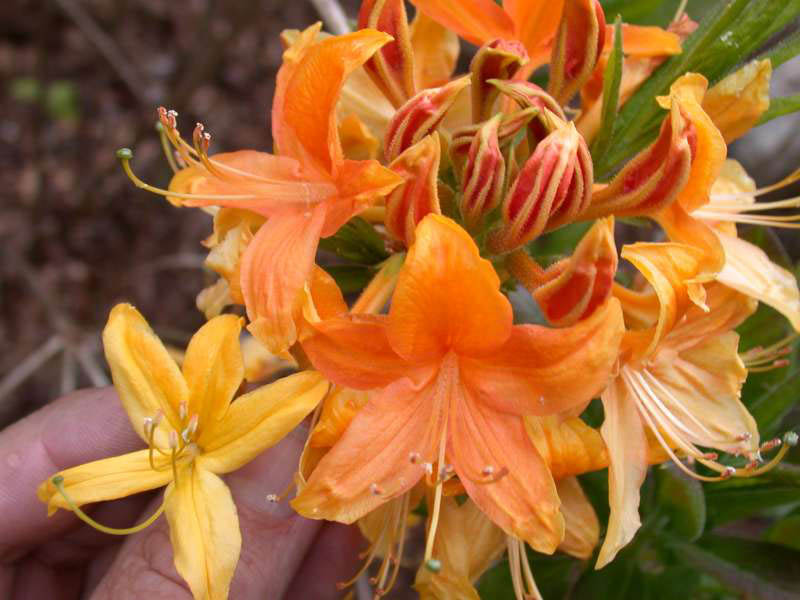
Orange R. luteum seedling compared to a standard form
Photo by Hans Eiberg
|
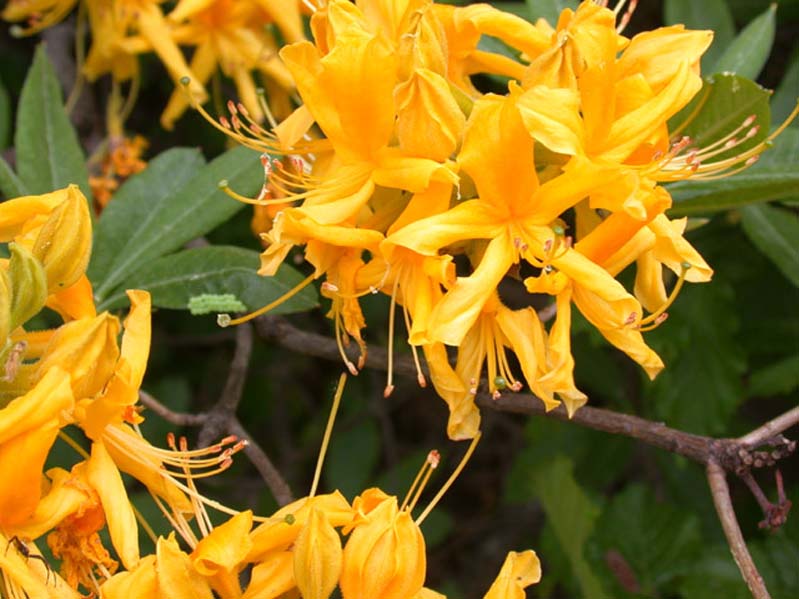
Narrow-Petaled Gold in the Wild
Photo by Hans Eiberg
|
| | |
Rhododendron occidentale
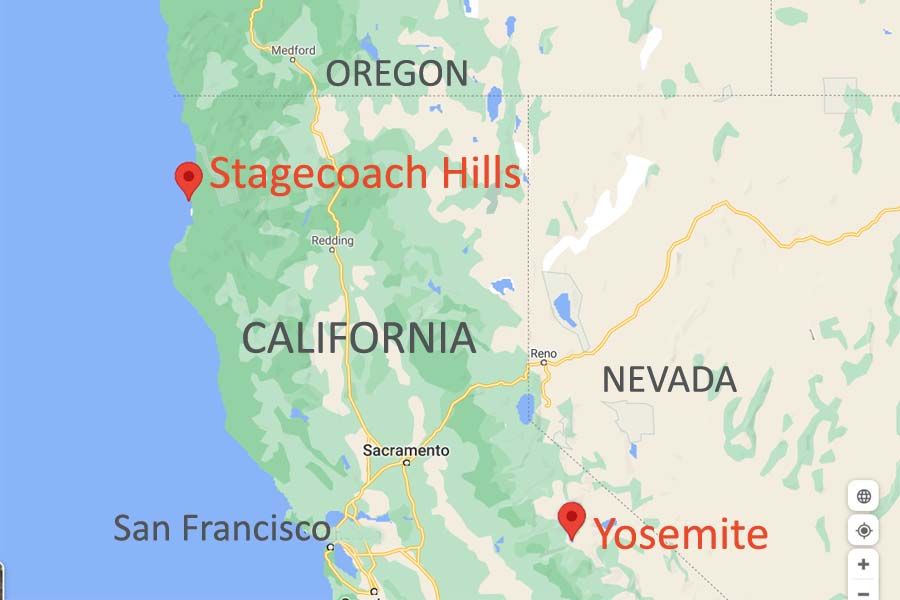 The spectacular native azalea of the western United States, R. occidentale, is a favorite garden plant in cooler climates but it can be very challenging in warm and humid regions like the Southeastern United States where I live. I do enjoy adding a few extra days whenever I travel to distant locations so I can have time to admire places that were not on the standard tour. This azalea's natural range is from southern Oregon along the coast through northern California. I understand there are scattered populations all the way to Baja California but I have not had a chance to see those locations. In addition to the plants along the coast, there are disjoint populations in the foothills of the Sierras. There are plants in the meadows of Yosemite National Park and along the Merced River. I have also seen plants growing beneath the Giant Redwoods in Sequoia and King's Canyon National Parks which is south of Yosemite.
The spectacular native azalea of the western United States, R. occidentale, is a favorite garden plant in cooler climates but it can be very challenging in warm and humid regions like the Southeastern United States where I live. I do enjoy adding a few extra days whenever I travel to distant locations so I can have time to admire places that were not on the standard tour. This azalea's natural range is from southern Oregon along the coast through northern California. I understand there are scattered populations all the way to Baja California but I have not had a chance to see those locations. In addition to the plants along the coast, there are disjoint populations in the foothills of the Sierras. There are plants in the meadows of Yosemite National Park and along the Merced River. I have also seen plants growing beneath the Giant Redwoods in Sequoia and King's Canyon National Parks which is south of Yosemite.
The flowers of this species can range from white to pink with a contrasting yellow, gold, or even orange blotch. A major attraction is that the blossoms are extremely fragrant, too. There are certain populations along the California Coast where the flower variations are quite pronounced. I have seen darker pink blossoms opening from red buds, bicolor blossoms including picotee forms, and striking ruffled or frilled flowers. One of the best places to see such diversity is at Stagecoach Hill in the Humboldt Lagoons State Park north of Eureka, CA.
Most of the photos in this section were taken by me on several different trips to the West Coast. The plants I have seen in Yosemite were not as varied as those at Stagecoach Hill, and seemed to be shades of white to light pink with a gold blotch. I must admit that I have never been there when R. occidentale is at peak bloom. With so much other dramatic scenery, I was spending most of my time looking up at granite facades, roaring waterfalls, and towering redwood trees rather than looking down at the azaleas for evidence of spent blossoms or precocious flower buds.
|
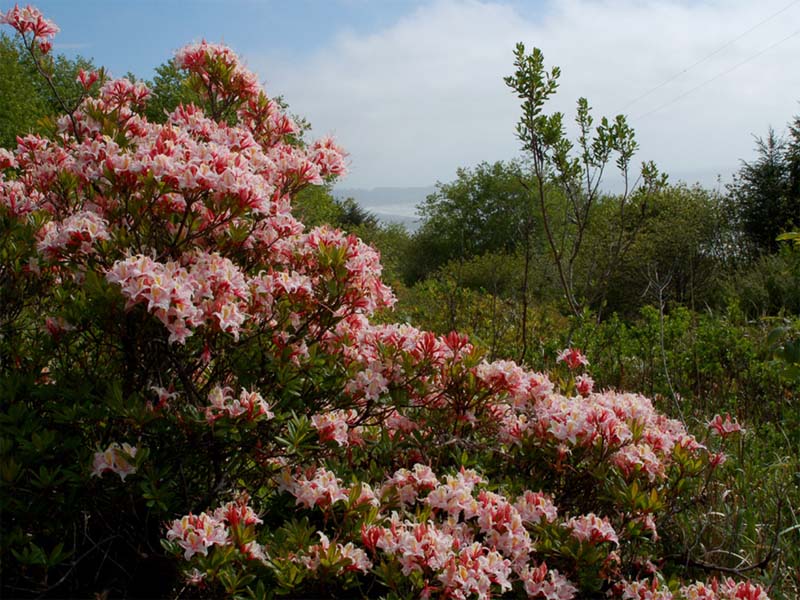
R. occidentale at Stagecoach Hill along the coast of Northern California
For more information about this region, the history of Stagecoach Hill, and some of the amazing R. occidentale selections found growing in that reserve, check out an article published by Singing Tree Gardens Nursery:
The Western Azaleas of Stagecoach Hill, CA
|
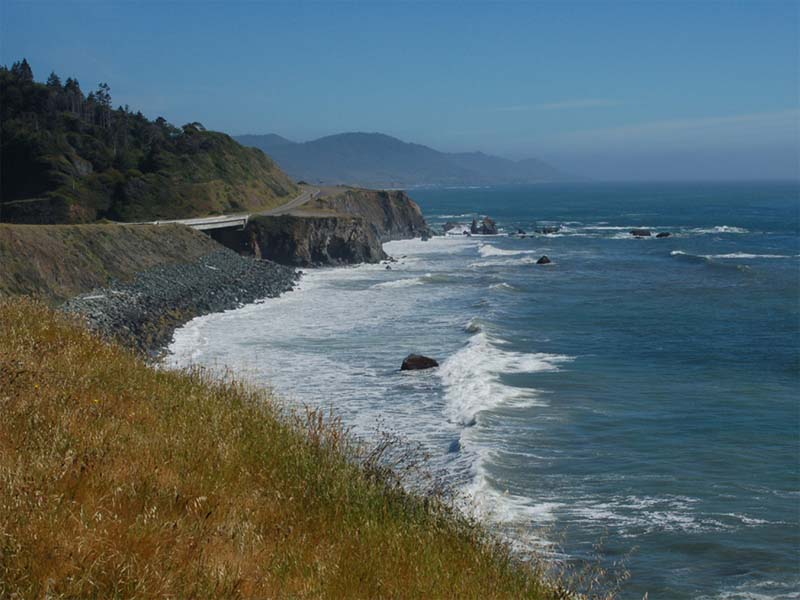
California Coast
|
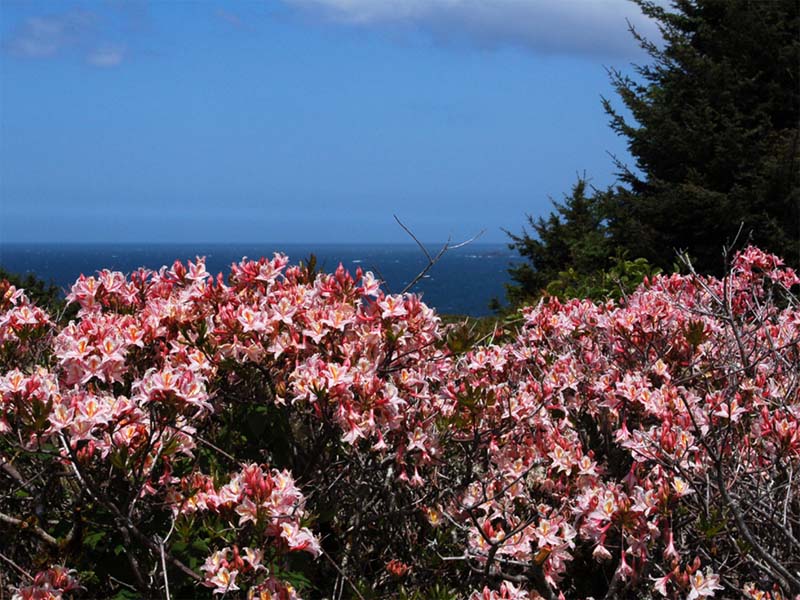
R. occidentale along the Coast
|
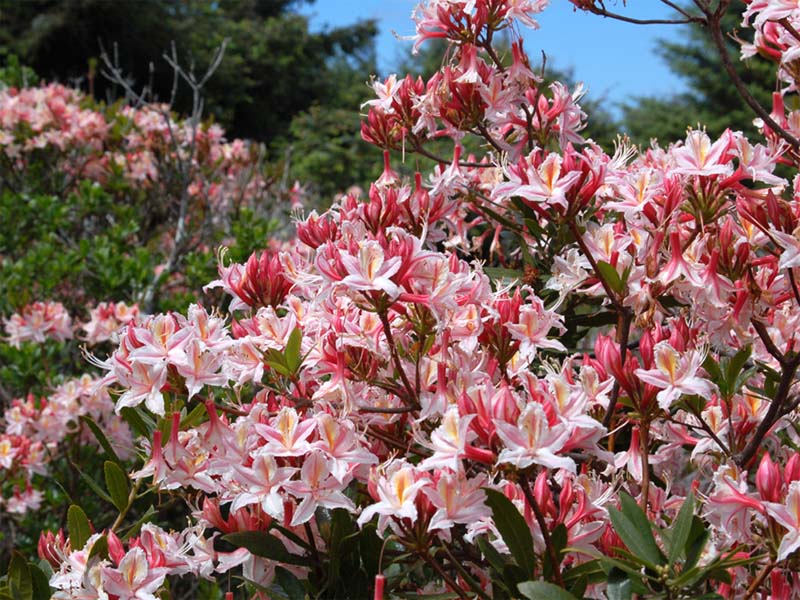
Striking Pink Form
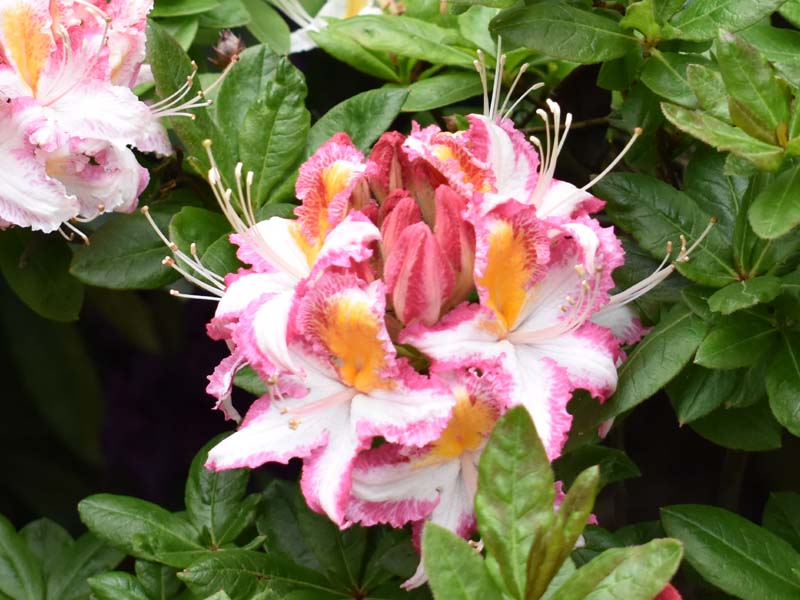
'Humboldt Picotee' - White Corolla with Rose Edge
|
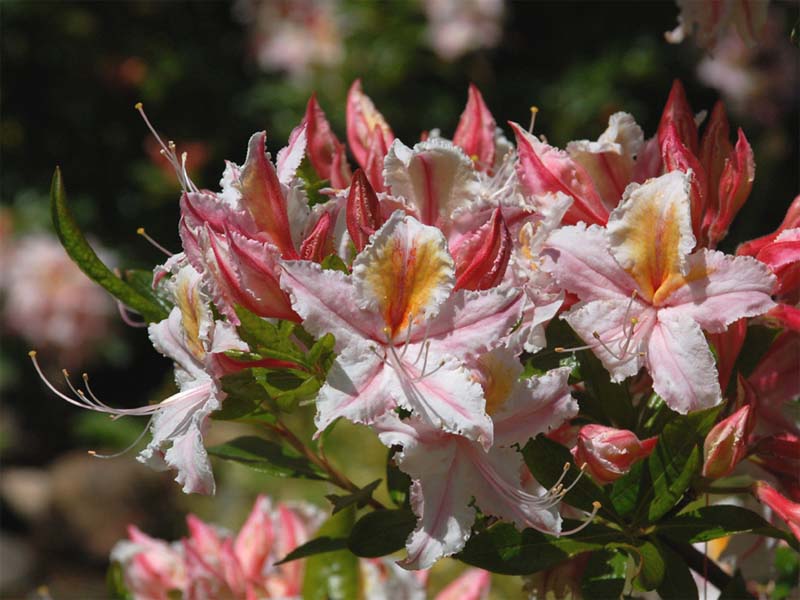
Frilled Pink Form
|
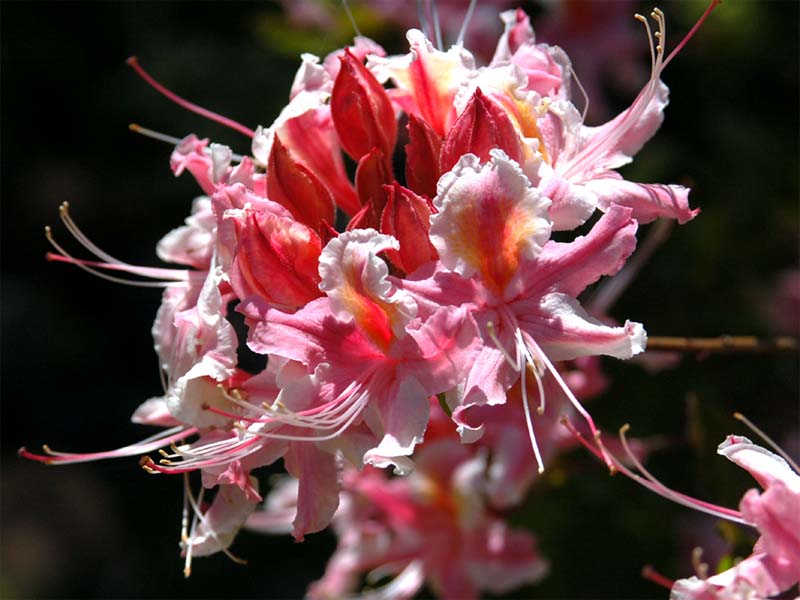
Deep Rose Pink with White Edge
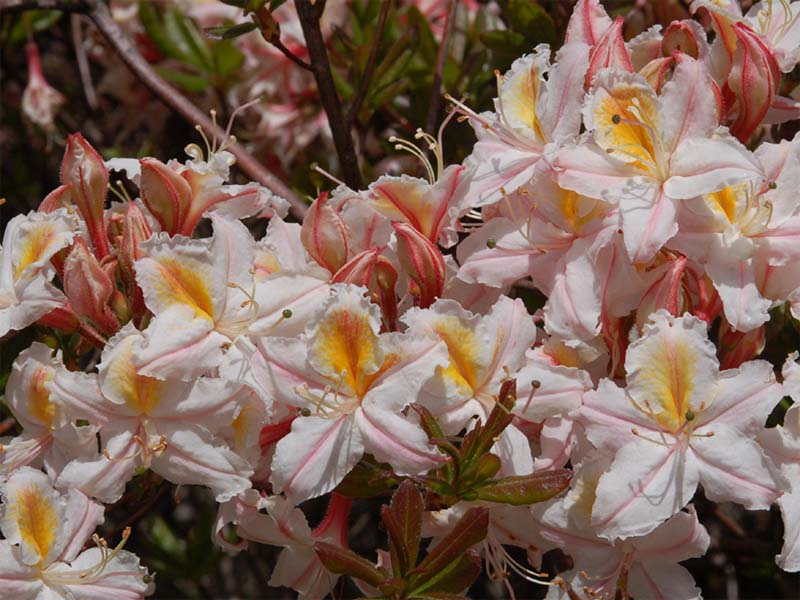
Ruffled Light Pink
|
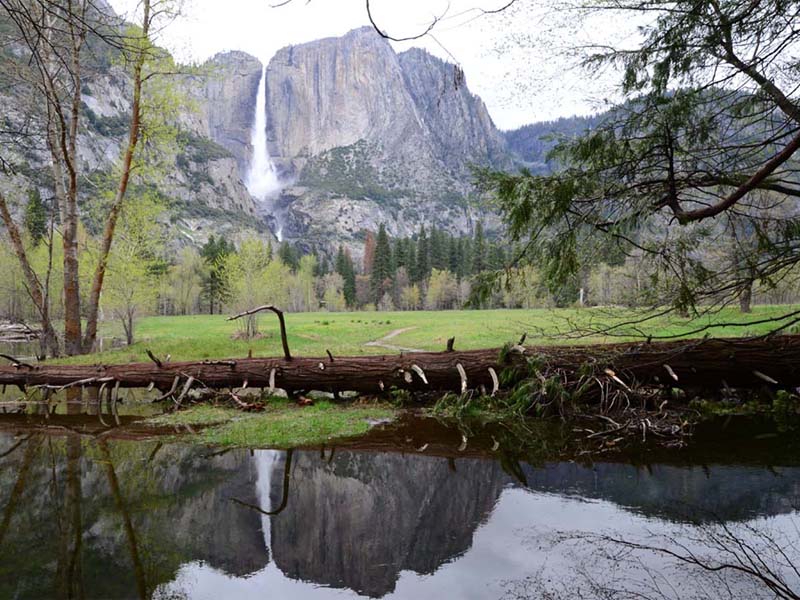
Yosemite Falls
|
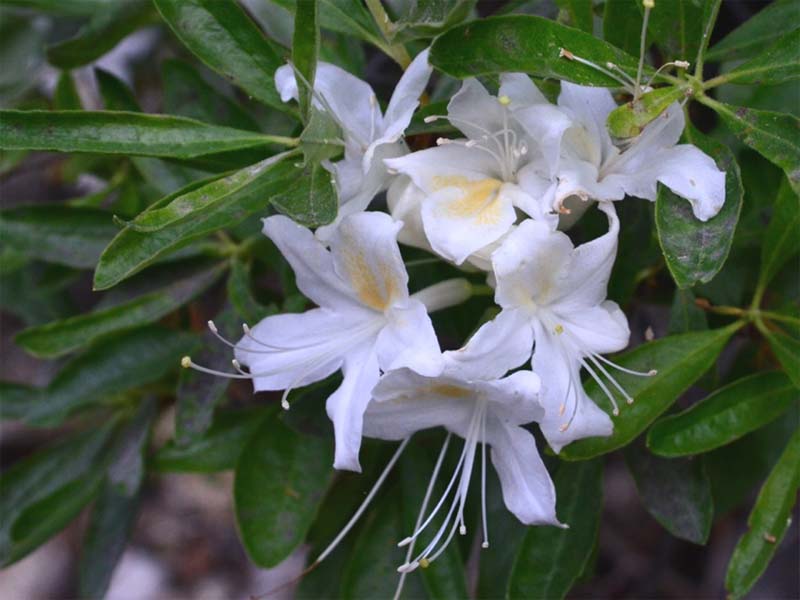
White R. occidentale in Yosemite
|
| |
|

 Rhododendron calendulaceum is surely one of the most highly prized of our North American native azaleas. The species is widespread in the Southern Appalachians and even a single plant sporting blossoms of brilliant yellow, orange, or red is a delight to behold. My favorite flame azalea display is along the Appalachian Trail at Roan Mountain located on the northern border between North Carolina and Tennessee. The trail winds through open balds at elevations of 5000 to 6000 ft (1500 to 1800 m) with 360-degree views. In June, huge stands of flame azaleas and masses of purple R. catawbiense burst into flower. The spectacle defies description. Farther to the south and still on the mountainous border between the two states is a second favorite spot, Hooper Bald. It has some of the largest flowered forms of the species we have ever seen.
Rhododendron calendulaceum is surely one of the most highly prized of our North American native azaleas. The species is widespread in the Southern Appalachians and even a single plant sporting blossoms of brilliant yellow, orange, or red is a delight to behold. My favorite flame azalea display is along the Appalachian Trail at Roan Mountain located on the northern border between North Carolina and Tennessee. The trail winds through open balds at elevations of 5000 to 6000 ft (1500 to 1800 m) with 360-degree views. In June, huge stands of flame azaleas and masses of purple R. catawbiense burst into flower. The spectacle defies description. Farther to the south and still on the mountainous border between the two states is a second favorite spot, Hooper Bald. It has some of the largest flowered forms of the species we have ever seen.



 North Carolina Vista at Engine Gap
North Carolina Vista at Engine Gap





















 Throughout much of Europe, the yellow deciduous azalea known as Rhododendron luteum has almost become naturalized. One might assume it was a native plant. The tall, spreading shrub covers itself with yellow flowers and their strong fragrance seems to perfume the entire garden. The plants seem to be rather uniform with slight variations in flower shape and growth habit. Blossoms can range from light greenish yellow to deep yellow, and even approaching gold. Most flowers have a deeper gold blotch although I have seen one that was decidedly green.
Throughout much of Europe, the yellow deciduous azalea known as Rhododendron luteum has almost become naturalized. One might assume it was a native plant. The tall, spreading shrub covers itself with yellow flowers and their strong fragrance seems to perfume the entire garden. The plants seem to be rather uniform with slight variations in flower shape and growth habit. Blossoms can range from light greenish yellow to deep yellow, and even approaching gold. Most flowers have a deeper gold blotch although I have seen one that was decidedly green.













 The spectacular native azalea of the western United States, R. occidentale, is a favorite garden plant in cooler climates but it can be very challenging in warm and humid regions like the Southeastern United States where I live. I do enjoy adding a few extra days whenever I travel to distant locations so I can have time to admire places that were not on the standard tour. This azalea's natural range is from southern Oregon along the coast through northern California. I understand there are scattered populations all the way to Baja California but I have not had a chance to see those locations. In addition to the plants along the coast, there are disjoint populations in the foothills of the Sierras. There are plants in the meadows of Yosemite National Park and along the Merced River. I have also seen plants growing beneath the Giant Redwoods in Sequoia and King's Canyon National Parks which is south of Yosemite.
The spectacular native azalea of the western United States, R. occidentale, is a favorite garden plant in cooler climates but it can be very challenging in warm and humid regions like the Southeastern United States where I live. I do enjoy adding a few extra days whenever I travel to distant locations so I can have time to admire places that were not on the standard tour. This azalea's natural range is from southern Oregon along the coast through northern California. I understand there are scattered populations all the way to Baja California but I have not had a chance to see those locations. In addition to the plants along the coast, there are disjoint populations in the foothills of the Sierras. There are plants in the meadows of Yosemite National Park and along the Merced River. I have also seen plants growing beneath the Giant Redwoods in Sequoia and King's Canyon National Parks which is south of Yosemite.









